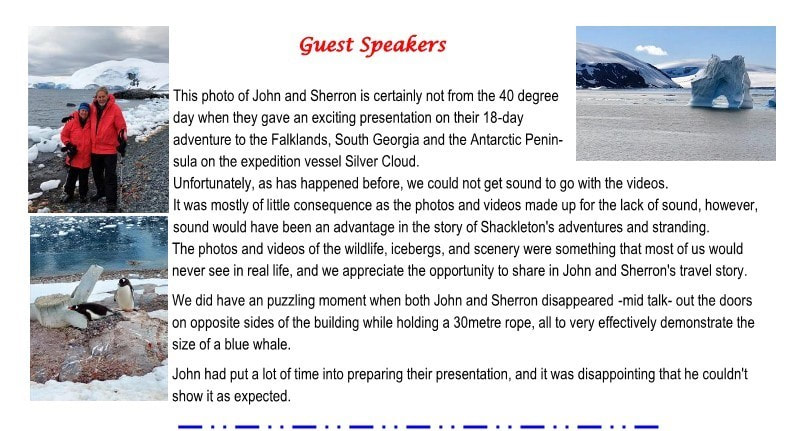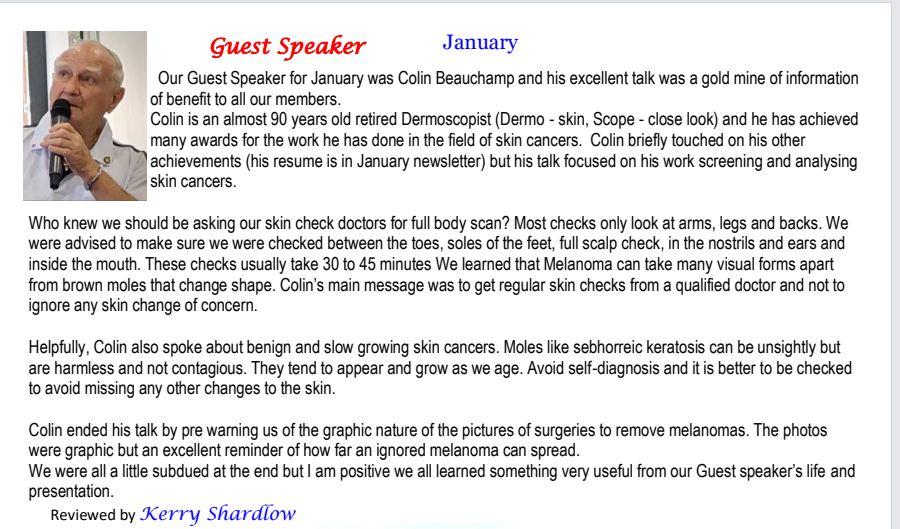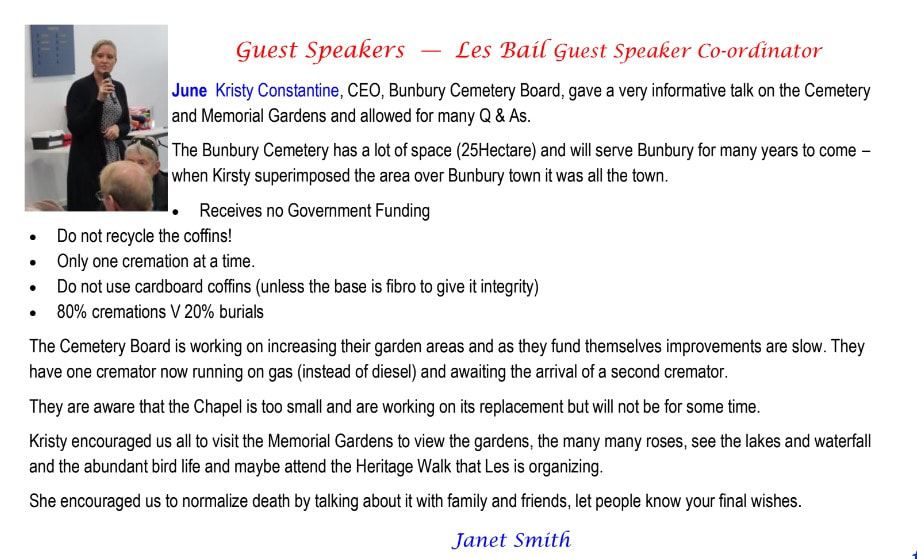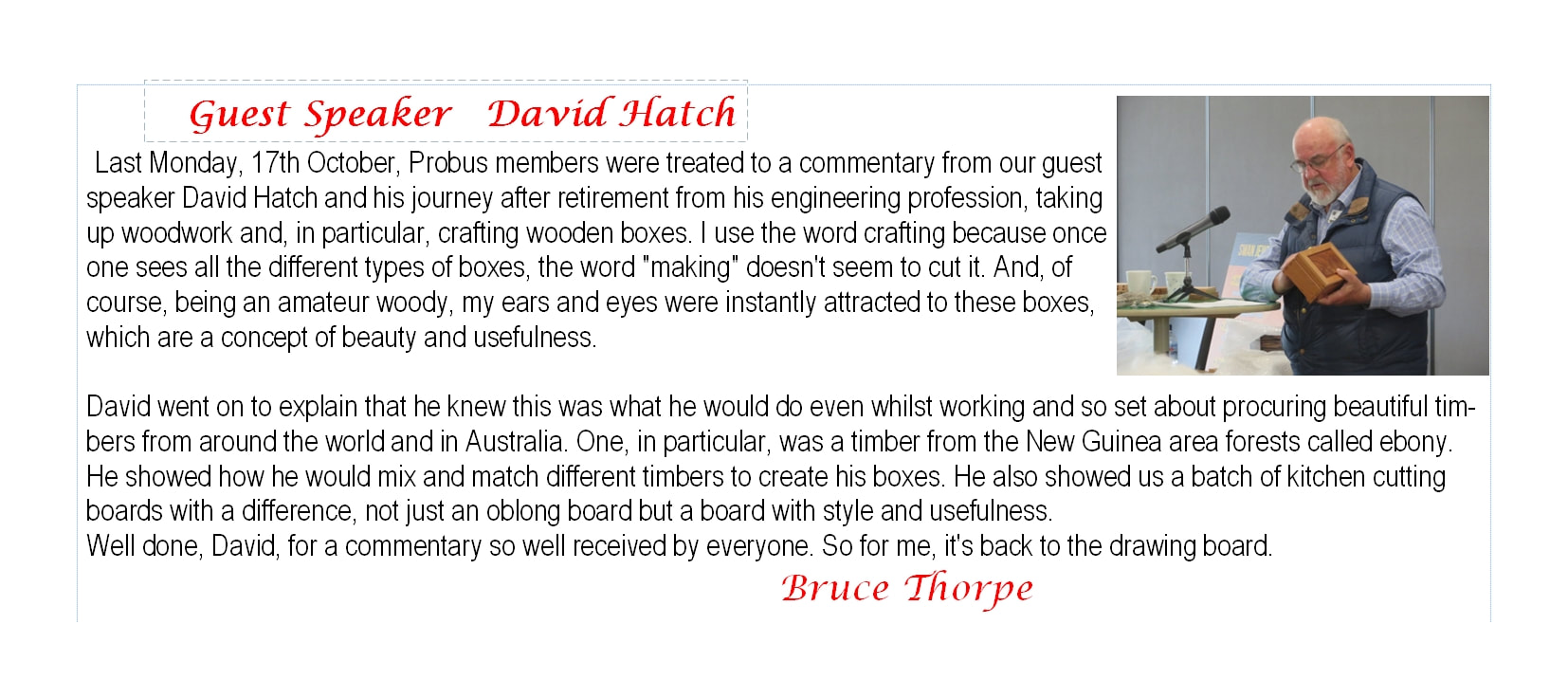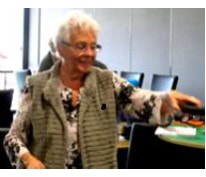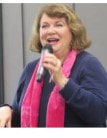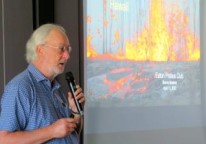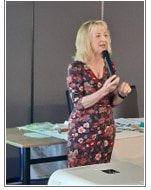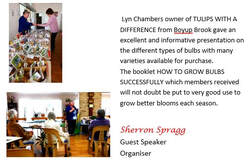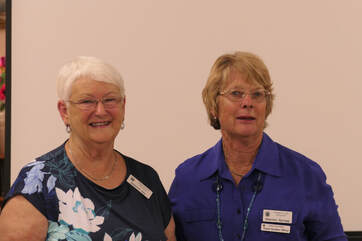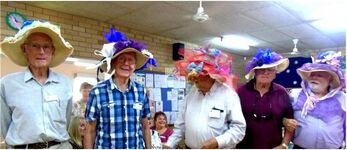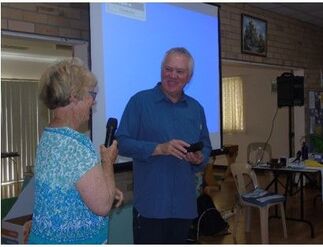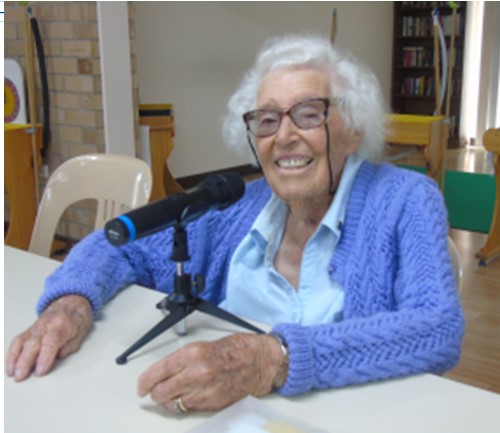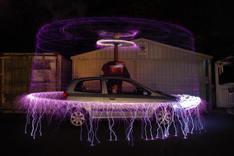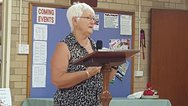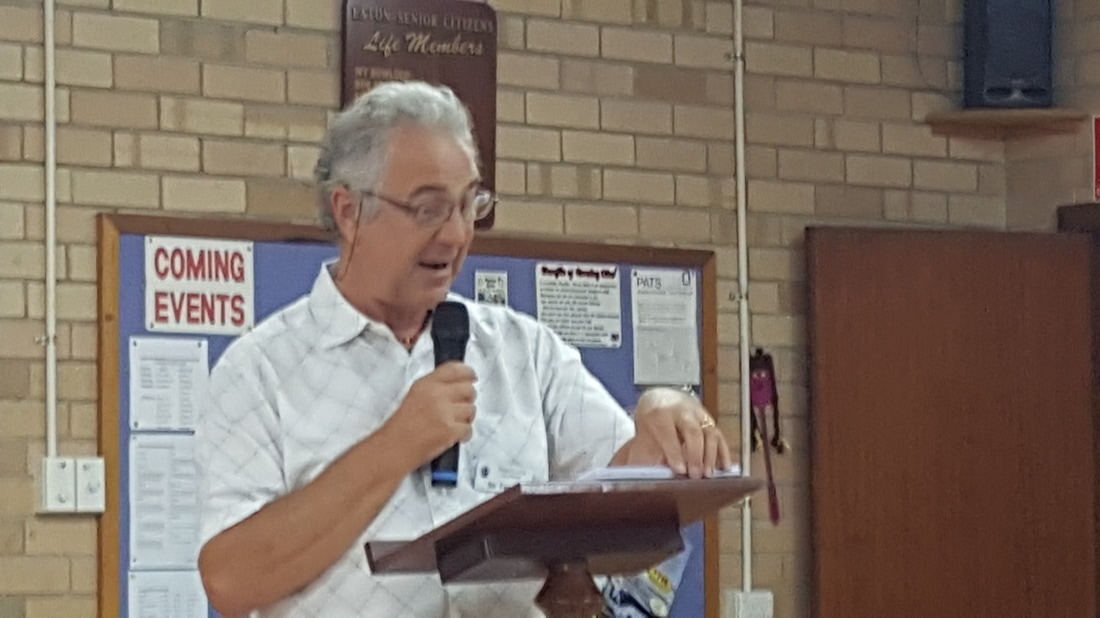
January 2021
Gwen Bennett, club member of 25 years.
|
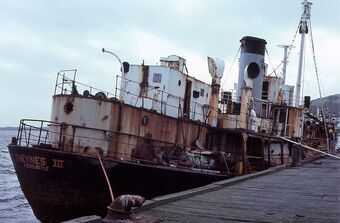
November 2020
Les Bail screened a video of the scuttling of the Cheynes 111. Early morning on the 23rd June 1982 was an important day for the Albany community, It was labelled by the media as "The end of an era" or was it just another chapter associated with the closing of the Cheynes Beach Whaling Company in 78? Closure of an industry that impacted on Albany's economy, loss of jobs both directly and indirectly, it took ten years for the economy to recover. It was an uncertain time with anti-whaling protesters continually active in the lead up to the closure.
For a small number of local divers, it was the culmination of months of hard work; that had its beginnings with South Coast Divers Club Inc making an application to The Jaycees Community Foundation Inc for the acquisition of the old whaler the Cheynes 111 for a dive wreck. The Club operated from the South Coast Diving Supplies shop for many years.
The Club secured the Cheynes 111 whaler, and it was time to tidy up all the legalities so work could begin. What an arduous undertaking. The ship, moored at the Town Jetty since 78, a caretaker on board, using the engine room as the rubbish bin. We were not permitted vehicles onto the jetty; rubbish wheelbarrowed and loaded into a truck for removal. It was a colossal undertaking; many working hours involved. The ship required to be squeaky clean, including the fuel oil tanks, before she went down.
Early on the 23rd June 1982, cleared to go, Fred Bairstow, Peter Kerr with towboats and Graham Leverett and boat to ferry the media. A group of divers aboard the ship for its last sail to the chosen site.
The Cheynes 111 was reluctant to depart the mooring she used since first arriving in Albany many years prior. It was as if a hidden force was holding her back from the watery grave. By the time we left the harbour, she had accepted her fate, and the wind was picking up so we could not delay.
We had been to the site earlier in the week to set an anchor to hold her fast while setting the charge. The wind had picked considerably, and she did drag the anchor that resulted in her final position being a bit off. Graham ferried Ron Thomas, the powder monkey alongside the vessel, once the charges armed to stand off one mile to comply conditions set by the Marine and Harbours Department's Inspector John Hallett. It turned out to be an impressive explosion resulting in it being all over in less than a minute. Another minute and divers had kitted up for an almost a ghostly sight: dazed fish, some feeding on growth dislodged by the blast.
Some community members were not in favour of scuttling the ship; others saw it as a viable option. The diving community, delighted with the wreck, 936 divers logged diving the wreck by the end of the Christmas school holidays that season.
Les Bail screened a video of the scuttling of the Cheynes 111. Early morning on the 23rd June 1982 was an important day for the Albany community, It was labelled by the media as "The end of an era" or was it just another chapter associated with the closing of the Cheynes Beach Whaling Company in 78? Closure of an industry that impacted on Albany's economy, loss of jobs both directly and indirectly, it took ten years for the economy to recover. It was an uncertain time with anti-whaling protesters continually active in the lead up to the closure.
For a small number of local divers, it was the culmination of months of hard work; that had its beginnings with South Coast Divers Club Inc making an application to The Jaycees Community Foundation Inc for the acquisition of the old whaler the Cheynes 111 for a dive wreck. The Club operated from the South Coast Diving Supplies shop for many years.
The Club secured the Cheynes 111 whaler, and it was time to tidy up all the legalities so work could begin. What an arduous undertaking. The ship, moored at the Town Jetty since 78, a caretaker on board, using the engine room as the rubbish bin. We were not permitted vehicles onto the jetty; rubbish wheelbarrowed and loaded into a truck for removal. It was a colossal undertaking; many working hours involved. The ship required to be squeaky clean, including the fuel oil tanks, before she went down.
Early on the 23rd June 1982, cleared to go, Fred Bairstow, Peter Kerr with towboats and Graham Leverett and boat to ferry the media. A group of divers aboard the ship for its last sail to the chosen site.
The Cheynes 111 was reluctant to depart the mooring she used since first arriving in Albany many years prior. It was as if a hidden force was holding her back from the watery grave. By the time we left the harbour, she had accepted her fate, and the wind was picking up so we could not delay.
We had been to the site earlier in the week to set an anchor to hold her fast while setting the charge. The wind had picked considerably, and she did drag the anchor that resulted in her final position being a bit off. Graham ferried Ron Thomas, the powder monkey alongside the vessel, once the charges armed to stand off one mile to comply conditions set by the Marine and Harbours Department's Inspector John Hallett. It turned out to be an impressive explosion resulting in it being all over in less than a minute. Another minute and divers had kitted up for an almost a ghostly sight: dazed fish, some feeding on growth dislodged by the blast.
Some community members were not in favour of scuttling the ship; others saw it as a viable option. The diving community, delighted with the wreck, 936 divers logged diving the wreck by the end of the Christmas school holidays that season.
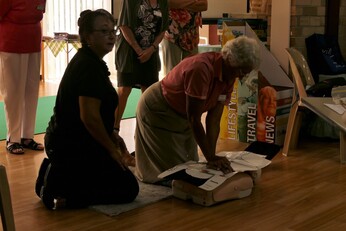
March 2020
Mrs Margaret Brookes, a training officer from Bunbury St John Ambulance Training, gave her qualifications before starting on her important and educational advice on what ‘to do’, and what ‘not to do’ when finding someone injured – either conscious (responsive) or unconscious (unresponsive) from a legal perspective. She demonstrated the following:- checking for any surrounding dangers, ascertaining a response, getting someone to ring 000 and report back, and if appropriate, to start CPR, all the Steps of the DRSABCD Action plan. (Danger, Respond, Send, Airway breathing, CPR). Margaret finished her talk showing members how to find and use a defibrillator, and everyone left the meeting knowing and understanding what to do if such a situation arises. Margaret was thanked for her wonderful talk and presented with a Probus pen in appreciation.
Judy Gilder
Mrs Margaret Brookes, a training officer from Bunbury St John Ambulance Training, gave her qualifications before starting on her important and educational advice on what ‘to do’, and what ‘not to do’ when finding someone injured – either conscious (responsive) or unconscious (unresponsive) from a legal perspective. She demonstrated the following:- checking for any surrounding dangers, ascertaining a response, getting someone to ring 000 and report back, and if appropriate, to start CPR, all the Steps of the DRSABCD Action plan. (Danger, Respond, Send, Airway breathing, CPR). Margaret finished her talk showing members how to find and use a defibrillator, and everyone left the meeting knowing and understanding what to do if such a situation arises. Margaret was thanked for her wonderful talk and presented with a Probus pen in appreciation.
Judy Gilder
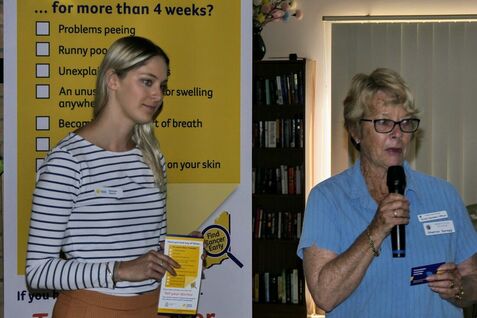
February 2020
Members welcomed Shenae Norris from the Cancer Council WA as the guest speaker for February.
In her speech and slide presentation Shenae gave members very important facts on the difference types of cancer and importantly how to identify them in the early stages.
She also made the point that if members were to suspect that there was any indication of cancer to see their GP or specialist and not partake in the self screening process as it may delay the prognosis .
It is also important to use sunscreen on a daily basis and not only when we are going to be in the sun for longer periods.
Sherron Spragg.
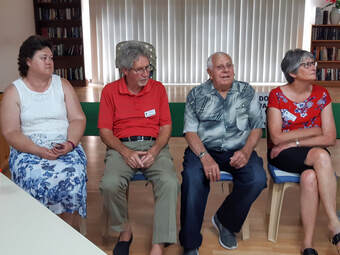
November 2019
This month we were privileged to have four members share with us some of their life stories and experiences.
Don Wass talked about how he and Rose took two young fellow campers under there wing in a hostile environment up north .
They gave them support and guidance to help them through a very rough time which demonstrates mateship at its very best.
Glenys Brennan spoke about her life growing up in Harvey and her challenges as a Army wife an in relation of having to move every few years and later her banking career also her great love of bush walking.
Peter Hill was born in Wagerup and incredibly was taught by fellow member Noreen White at the local primary school .
He spoke about his early days when he and Emily established a dairy farm at Cookernup .
In 1990 they moved to Binningup before shifting to Treendale some years later.
Noreen White told us that she had always wanted to be a teacher which at times seemed impossible but through hard work and dedication she with the help of her teacher achieved her dream .
She also spoke about the love most teachers have for their students .
Jo Bright gave an interesting talk on her career in banking and told us how she became involved in embroidery then brought a craft shop in Armidale.
She then displayed samples of her exceptional work , quite remarkable as she is self taught.
To know the background and experiences of fellow members through their lives is a real privilege and enhances our relationships in Probus .
As they say everyone has a remarkable story to share and I’m sure members will look forward to our next members forum.
exceptional
Sherron Spragg.
This month we were privileged to have four members share with us some of their life stories and experiences.
Don Wass talked about how he and Rose took two young fellow campers under there wing in a hostile environment up north .
They gave them support and guidance to help them through a very rough time which demonstrates mateship at its very best.
Glenys Brennan spoke about her life growing up in Harvey and her challenges as a Army wife an in relation of having to move every few years and later her banking career also her great love of bush walking.
Peter Hill was born in Wagerup and incredibly was taught by fellow member Noreen White at the local primary school .
He spoke about his early days when he and Emily established a dairy farm at Cookernup .
In 1990 they moved to Binningup before shifting to Treendale some years later.
Noreen White told us that she had always wanted to be a teacher which at times seemed impossible but through hard work and dedication she with the help of her teacher achieved her dream .
She also spoke about the love most teachers have for their students .
Jo Bright gave an interesting talk on her career in banking and told us how she became involved in embroidery then brought a craft shop in Armidale.
She then displayed samples of her exceptional work , quite remarkable as she is self taught.
To know the background and experiences of fellow members through their lives is a real privilege and enhances our relationships in Probus .
As they say everyone has a remarkable story to share and I’m sure members will look forward to our next members forum.
exceptional
Sherron Spragg.
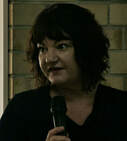
October 2019
Doreen gave a very informative speech on the complex circumstances involved in the protection of families from abuse is our local community
It gave members an insight into the many issues facing her team especially the struggle for funding and not enough Housing facilities in the South West.
As clothing and food are a very important part of supporting the family members under threat it would be of great benefit to them if members could bring any donations to the November meeting or the coffee club breakfast on the 11th of November. Doreen gave special thanks to our fellow member Dortea for the outstanding support she gives the the organisation in collecting items needed by the South West Refuge.
Members who would like to donate food and clothing on a regular basic can leave the items with Dortea at our monthly meetings.
Sherron Spragg - Guest Speaker Officer
Doreen gave a very informative speech on the complex circumstances involved in the protection of families from abuse is our local community
It gave members an insight into the many issues facing her team especially the struggle for funding and not enough Housing facilities in the South West.
As clothing and food are a very important part of supporting the family members under threat it would be of great benefit to them if members could bring any donations to the November meeting or the coffee club breakfast on the 11th of November. Doreen gave special thanks to our fellow member Dortea for the outstanding support she gives the the organisation in collecting items needed by the South West Refuge.
Members who would like to donate food and clothing on a regular basic can leave the items with Dortea at our monthly meetings.
Sherron Spragg - Guest Speaker Officer
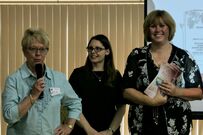
September 2019,
The guest speaker for September was Amanda Owen-Tucker from HANCOCK MEMORIALS she gave a very interesting talk and slide presentation on the history and different processes used by stone masons and their craftsmanship to create a memorial .
Lisa Miles also attended and gave members details of the different types of granite mined from quarries in Albany,Esperance and the Porongurups as well as the history of the Hancock and Bovelle families.
Lisa also invited members who were interested to contact her for a tour of the HANCOCK MEMORIALS facilities in Davenport.
A most informative presentation by giving members an insight to memorial design and types of lettering to reflect a persons personality.
Sherron Spragg - Guest Speaker Officer
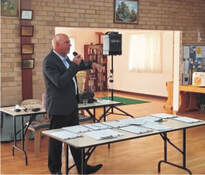
August 2019
Brendan Kelly Bunbury Councillor and Chair of the Bunbury Oral History Group gave us a new insight into what he called the B-side stories of local history.
He concentrated on the early nineteenth century when Bunbury was an important port town with ships from around the world coming here to pick up cargo and the seedy area adjacent to the wharf.
It was very interesting for the members to hear these untold famous and infamous stories of Bunbury from the newspapers of the day but then the people involved after a fleeting glimpse of notoriety disappeared into our forgotten history .
Brendan’s presentation was good old fashioned story telling.
Photo credit Ian Farrell Sherron Spragg Guest speaker officer
Brendan Kelly Bunbury Councillor and Chair of the Bunbury Oral History Group gave us a new insight into what he called the B-side stories of local history.
He concentrated on the early nineteenth century when Bunbury was an important port town with ships from around the world coming here to pick up cargo and the seedy area adjacent to the wharf.
It was very interesting for the members to hear these untold famous and infamous stories of Bunbury from the newspapers of the day but then the people involved after a fleeting glimpse of notoriety disappeared into our forgotten history .
Brendan’s presentation was good old fashioned story telling.
Photo credit Ian Farrell Sherron Spragg Guest speaker officer
July 2019 No guest speaker this month.
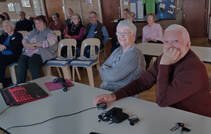
June 2019
No guest speaker per se this month, instead we were taken back in time with a presentation put together by President Dorothy. One of our Founding members supplied Dorothy with some old prints that reached deep into club history along with material from the past five or six years or so of outings, activities and fun times. These were all collated and presented as very professional videos set to music.that was very well received by old and new members alike.
No guest speaker per se this month, instead we were taken back in time with a presentation put together by President Dorothy. One of our Founding members supplied Dorothy with some old prints that reached deep into club history along with material from the past five or six years or so of outings, activities and fun times. These were all collated and presented as very professional videos set to music.that was very well received by old and new members alike.
|
May 2019
Taryn Davis from South West Waste Management and Recycling gave an informative talk on the Council’s implementation of a third bin for organic household waste, which is composted and then sold. These bins will also be issued by the Harvey Shire Council in the near future. We will organise an outing to tour the sites to see first hand the active approach being undertaken. A most informative presentation with our questions on recycling happily answered. |
|
|
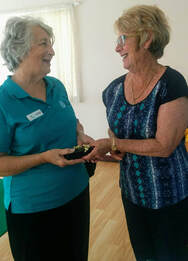
April 2019
Our guest speaker for April was Cynthia Robertson from STAY ON YOUR
FEET WA , who gave a tremendous talk and video presentation on prevention of falls which members found Invaluable and on how to work to
move our body , improve our health, checking medications and importantly
identifying the hazards around the home to avoid accidents She also issued
all members with pamphlets which will be helpful information in protecting
our members health and well-being.
Our guest speaker for April was Cynthia Robertson from STAY ON YOUR
FEET WA , who gave a tremendous talk and video presentation on prevention of falls which members found Invaluable and on how to work to
move our body , improve our health, checking medications and importantly
identifying the hazards around the home to avoid accidents She also issued
all members with pamphlets which will be helpful information in protecting
our members health and well-being.
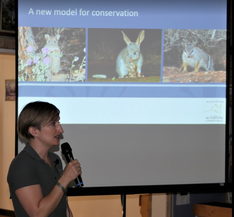
March 2019
Angela Bowman travelled from Perth to impart her vast knowledge of The Australian Wildlife Conservancy activities conducted across Australia. Angela had an excellent visual presentation and explained the challenges the organization faces in what is a mammoth undertaking. The origin of the organisation lies in a 1991 land purchase (of what is now Karakamia Sanctuary) by AWC’s founder, Martin Copley. In 2001 the AWC became a public charitable organization.In 2002 The AWC agreed to acquire four sanctuaries, Buckaringa, Dakalanta, Scotia and Yookamurra, for A$5.2m from Earth Sanctuaries Ltd (ESL), the company founded by Dr John Wamsley.
There is far too much information to condense for this article but by clicking the red highlights you can glean more information. It was a very professional and informative presentation that was well received by our members.
Angela Bowman travelled from Perth to impart her vast knowledge of The Australian Wildlife Conservancy activities conducted across Australia. Angela had an excellent visual presentation and explained the challenges the organization faces in what is a mammoth undertaking. The origin of the organisation lies in a 1991 land purchase (of what is now Karakamia Sanctuary) by AWC’s founder, Martin Copley. In 2001 the AWC became a public charitable organization.In 2002 The AWC agreed to acquire four sanctuaries, Buckaringa, Dakalanta, Scotia and Yookamurra, for A$5.2m from Earth Sanctuaries Ltd (ESL), the company founded by Dr John Wamsley.
There is far too much information to condense for this article but by clicking the red highlights you can glean more information. It was a very professional and informative presentation that was well received by our members.

February 2019
We had an interesting talk by Dardanup Shire President, Mick Bennett on future planning for the shire. Mick is an excellent speaker and our members were well informed on future plans for the year ahead and beyond. We ran out question time and that is usually a good gauge to the quality of the speaker, the informative information/topics presented in easily followed dialogue. It was excellent presentation by a passionate speaker.
We had an interesting talk by Dardanup Shire President, Mick Bennett on future planning for the shire. Mick is an excellent speaker and our members were well informed on future plans for the year ahead and beyond. We ran out question time and that is usually a good gauge to the quality of the speaker, the informative information/topics presented in easily followed dialogue. It was excellent presentation by a passionate speaker.
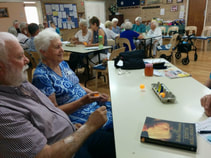
January 2019
It was decided to have a change of format this month due to the number of members away on holidays. The guest speaker time was used for fun and games and this proved to be well received and a lot fun. We recycled some of the games from the Southwest Get Together held in October last year.
It was decided to have a change of format this month due to the number of members away on holidays. The guest speaker time was used for fun and games and this proved to be well received and a lot fun. We recycled some of the games from the Southwest Get Together held in October last year.
December 2018
We did not have a guest speaker in December due to our meeting conducted in conjunction with our Christmas Lunch at the Brunswick Tavern.
We did not have a guest speaker in December due to our meeting conducted in conjunction with our Christmas Lunch at the Brunswick Tavern.
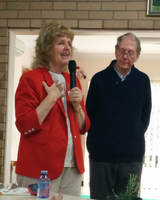
November 2018
Alan and Maureen Worthington, Eaton Probus members were our guest speakers for November. Maureen & Alan spoke of their decision to come to Australia and their eventual arrival in 1980. Both related some of the humorous stories of their life since coming out to Australia (from the UK). After spending almost 10 years in Perth they moved to Bridgetown and purchased a Boarding Kennels and Cattery business which led to many amusing incidents. Maureen was on her own for most of the allocated time as Alan had an unexpected appointment that took far longer than anticipated. Never the less Maureen kept us entertained as she recalled the trials and tribulations of running their own businesses in Bridgetown. Alan did have time to tell his stories and fill in any gaps Maureen had left.There were many humorous sides to the experiences they have had along life's journey.
Alan and Maureen Worthington, Eaton Probus members were our guest speakers for November. Maureen & Alan spoke of their decision to come to Australia and their eventual arrival in 1980. Both related some of the humorous stories of their life since coming out to Australia (from the UK). After spending almost 10 years in Perth they moved to Bridgetown and purchased a Boarding Kennels and Cattery business which led to many amusing incidents. Maureen was on her own for most of the allocated time as Alan had an unexpected appointment that took far longer than anticipated. Never the less Maureen kept us entertained as she recalled the trials and tribulations of running their own businesses in Bridgetown. Alan did have time to tell his stories and fill in any gaps Maureen had left.There were many humorous sides to the experiences they have had along life's journey.
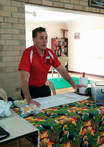
October 2018
Gino’s Hand Raised Birds is owned and operated by Gino Pacini our guest speaker for October. Gino arrived in time for morning tea and brought along his family of five Cockatiels and two baby Eclectus parrots that he was hand raising. It was obvious that these two species were favorites of Ginos and for those who know little about birds native to Australia, below is a description of both species.
The Eclectus Parrot is found on Eastern Cape York Peninsula, from Pascoe River south to Massey Creek and inland to McIlwraith Range and is locally common. Also widely distributed from Solomon islands west through New Guinea to the Moluccas The Eclectus Parrot is found in the canopy of rain forests and in adjacent eucalypt woodlands. Eclectus Parrot nests in a big hole 50cm to 6m deep in the trunk of a tall tree at the edge of or in a clearing in the forest. The eggs are laid on a lining of chips and decayed wood dust. Incubation is by the female over about 26 days. Both parents care for the chicks and seem to be helped in the task. Reports state that up to eight birds of both sexes appear to attend the nests. The young leave the nest 11-12 weeks after hatching
Cockatiel
The Cockatiel mainly occurs in inland regions of Australia, avoiding continuously wooded areas, and preferring areas of open country, where it can forage on the ground. Sometimes they congregate to eat spilled wheat along roadsides, where they are often struck by vehicles. Like many birds of the inland, the movements of the Cockatiel appear to be influenced by rainfall, with birds breeding up in good numbers during wet periods, but then, during subsequent droughts, large numbers are forced to move into regions where they seldom occur. The Cockatiel is an unusual member of the cockatoo family. It is small in size and has a slender body and long pointed tail, which is more characteristic of the smaller parrots. Its plumage is mostly grey, paler below, with a white wing patch, orange cheeks, and a distinctive pointed crest. The male can be identified by its bright yellow forehead, face, and crest. Young Cockatiels resemble the adult female, although the young males usually have a brighter yellow face. The Cockatiel is not found naturally in any other country, but is a popular cage bird, second only to the Budgerigar, Melopsittacus undulates. The Cockatiel is widespread throughout mainland Australia, but is uncommon in Tasmania, with only a few sightings being reported to date. Cockatiels may breed at any time, in response to suitable periods of rain, especially in the more arid regions. Both sexes share the incubation of the eggs, which are laid in a hollow, high up in trees. Suitable trees are either in or close to water. Cockatiels enter the nest hollow tail first.
Gino’s Hand Raised Birds is owned and operated by Gino Pacini our guest speaker for October. Gino arrived in time for morning tea and brought along his family of five Cockatiels and two baby Eclectus parrots that he was hand raising. It was obvious that these two species were favorites of Ginos and for those who know little about birds native to Australia, below is a description of both species.
The Eclectus Parrot is found on Eastern Cape York Peninsula, from Pascoe River south to Massey Creek and inland to McIlwraith Range and is locally common. Also widely distributed from Solomon islands west through New Guinea to the Moluccas The Eclectus Parrot is found in the canopy of rain forests and in adjacent eucalypt woodlands. Eclectus Parrot nests in a big hole 50cm to 6m deep in the trunk of a tall tree at the edge of or in a clearing in the forest. The eggs are laid on a lining of chips and decayed wood dust. Incubation is by the female over about 26 days. Both parents care for the chicks and seem to be helped in the task. Reports state that up to eight birds of both sexes appear to attend the nests. The young leave the nest 11-12 weeks after hatching
Cockatiel
The Cockatiel mainly occurs in inland regions of Australia, avoiding continuously wooded areas, and preferring areas of open country, where it can forage on the ground. Sometimes they congregate to eat spilled wheat along roadsides, where they are often struck by vehicles. Like many birds of the inland, the movements of the Cockatiel appear to be influenced by rainfall, with birds breeding up in good numbers during wet periods, but then, during subsequent droughts, large numbers are forced to move into regions where they seldom occur. The Cockatiel is an unusual member of the cockatoo family. It is small in size and has a slender body and long pointed tail, which is more characteristic of the smaller parrots. Its plumage is mostly grey, paler below, with a white wing patch, orange cheeks, and a distinctive pointed crest. The male can be identified by its bright yellow forehead, face, and crest. Young Cockatiels resemble the adult female, although the young males usually have a brighter yellow face. The Cockatiel is not found naturally in any other country, but is a popular cage bird, second only to the Budgerigar, Melopsittacus undulates. The Cockatiel is widespread throughout mainland Australia, but is uncommon in Tasmania, with only a few sightings being reported to date. Cockatiels may breed at any time, in response to suitable periods of rain, especially in the more arid regions. Both sexes share the incubation of the eggs, which are laid in a hollow, high up in trees. Suitable trees are either in or close to water. Cockatiels enter the nest hollow tail first.
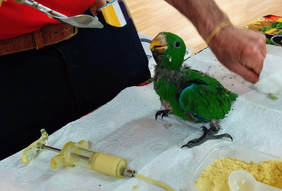
Gino explained the feeding process in detail, the food formula, tools that are used to safely allow them to feed. He then demonstrated how this was done much to the delight of the audience. The birds knew who the de-facto mother was in this instance, and were clamoring for attention. For a speaker who was unsure how he was going to fill his time, he managed to have everyone’s undivided attention for just over an hour. All in all a most enjoyable relaxed atmosphere with plenty of question time.
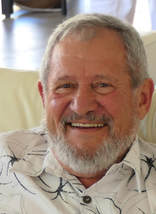
September 2018
Our guest speaker for August was be one of our own again, Bob Smith. Bob was well qualified to speak to us about his time as a “forester” if that is the correct word. Bob undertook his studies in England before bringing his expertise to Australia and working with DEC. Bob related stories of how he started his career and studies in England . Being a Yorkshire-man there was a smattering of humour along the way mainly directed at himself. He then moved onto his life as a forester in Australia. He spent considerable time studying controlled burn techniques in conjunction with the CSIRO. Things were certainly very different 40 years ago. Bob also mentioned that he found the Australian forests very different to what he was used to England. I feel that possibly made the job more interesting for him in the early days and led to an appreciation of the beautiful end product that was derived from our humble WA Jarrah tree. There followed a lively Q&A session until it was time to pack up and go to lunch at the Rose Hotel. Thank you.
Our guest speaker for August was be one of our own again, Bob Smith. Bob was well qualified to speak to us about his time as a “forester” if that is the correct word. Bob undertook his studies in England before bringing his expertise to Australia and working with DEC. Bob related stories of how he started his career and studies in England . Being a Yorkshire-man there was a smattering of humour along the way mainly directed at himself. He then moved onto his life as a forester in Australia. He spent considerable time studying controlled burn techniques in conjunction with the CSIRO. Things were certainly very different 40 years ago. Bob also mentioned that he found the Australian forests very different to what he was used to England. I feel that possibly made the job more interesting for him in the early days and led to an appreciation of the beautiful end product that was derived from our humble WA Jarrah tree. There followed a lively Q&A session until it was time to pack up and go to lunch at the Rose Hotel. Thank you.
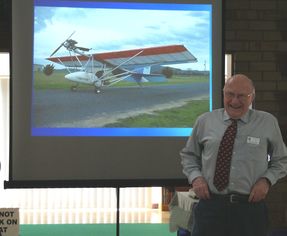
August 2018
Our guest speaker was Max Collins, currently VP of the Vasse Probus Club.
Initially Max provided us with some background facts. In summary, I am a now-retired pilot of 48 years and 23,500 hours flying including Air Force, Cathay Pacific, Corporate, Ansett and China Southern Flying College experience.
Started flying 1960 in the RAAF. Instructed at Pearce and then flew Hercules aircraft from Richmond NSW for four years incl many ops to Vietnam. Resigned from Air Force 1970 to join Cathay Pacific in Hong Kong. Flew Convair 880, Boeing 707, Lockheed L1011 Tristar and Boeing 747. Resigned from Cathay in 1985. Operated ultralight aircraft for a while then accepted an offer to go Corporate. Joined Ansett after the 1989 pilot's dispute and stayed until the end. Was Check and Training and Flight Ops Manager. Then taught Singapore Airlines cadets. Then Chief Pilot at China Southern WA Flying College.
Max’s walked us through his working life story in the aviation industry, punctuated with some excellent slides. From the outset it was not hard to realize Max is as passionate about aircraft today as he was as a child that ultimately led him to realize his childhood dream of becoming a pilot. Max answered a lot of our questions and doubts about flying in general. Thank you.
Our guest speaker was Max Collins, currently VP of the Vasse Probus Club.
Initially Max provided us with some background facts. In summary, I am a now-retired pilot of 48 years and 23,500 hours flying including Air Force, Cathay Pacific, Corporate, Ansett and China Southern Flying College experience.
Started flying 1960 in the RAAF. Instructed at Pearce and then flew Hercules aircraft from Richmond NSW for four years incl many ops to Vietnam. Resigned from Air Force 1970 to join Cathay Pacific in Hong Kong. Flew Convair 880, Boeing 707, Lockheed L1011 Tristar and Boeing 747. Resigned from Cathay in 1985. Operated ultralight aircraft for a while then accepted an offer to go Corporate. Joined Ansett after the 1989 pilot's dispute and stayed until the end. Was Check and Training and Flight Ops Manager. Then taught Singapore Airlines cadets. Then Chief Pilot at China Southern WA Flying College.
Max’s walked us through his working life story in the aviation industry, punctuated with some excellent slides. From the outset it was not hard to realize Max is as passionate about aircraft today as he was as a child that ultimately led him to realize his childhood dream of becoming a pilot. Max answered a lot of our questions and doubts about flying in general. Thank you.

July 2018
Our Guest speaker for July was Dorothy Bail (President The Probus Club of Eaton).
Dorothy has had an interest in all things photography and since retirement had progressed her hobby for many years, to producing video presentations for family and friends. Thankfully she decided to share her Okeefenokee Swamp video with us. After a short introduction of where the swamp is situated in relation to Georgia and Florida by way of a couple of maps and interesting statistics the most memorable being estimated number of 20,000 alligators in the swamp and one black bear per square mile, the swamp being 700 square miles.
The lights dimmed and we commenced our journey into the depths of the man-made canals with beautiful cypress trees on either side of the canals. It did not take long to realize that the estimated number was pretty accurate based on the numbers seen in the first few minutes of our journey. Dorothy had recorded the Tour Guides narration and he imparted his extensive knowledge of the wildlife, birds and history of the swamp that were seen as our journey progressed.
We were able to immerse ourselves fully into the serene, calm environment with beautiful tree and bird reflections in the calm dark tannin filled water. We turned from the canal into what the locals call the prairie and took in the beauty of the carpet of water lilies and many other species of aquatic plants, some endemic to the Okefenokee Swamp. It was dinner time for the alligators and Dorothy had managed to film one feeding on a fish up on the surface. I could go on and on but space does not permit that. I feel that we were very fortunate to have the opportunity to share in Dorothy’s memorable journey through the Okeefenokee Swamp and all that went with it. Thank you.
Our Guest speaker for July was Dorothy Bail (President The Probus Club of Eaton).
Dorothy has had an interest in all things photography and since retirement had progressed her hobby for many years, to producing video presentations for family and friends. Thankfully she decided to share her Okeefenokee Swamp video with us. After a short introduction of where the swamp is situated in relation to Georgia and Florida by way of a couple of maps and interesting statistics the most memorable being estimated number of 20,000 alligators in the swamp and one black bear per square mile, the swamp being 700 square miles.
The lights dimmed and we commenced our journey into the depths of the man-made canals with beautiful cypress trees on either side of the canals. It did not take long to realize that the estimated number was pretty accurate based on the numbers seen in the first few minutes of our journey. Dorothy had recorded the Tour Guides narration and he imparted his extensive knowledge of the wildlife, birds and history of the swamp that were seen as our journey progressed.
We were able to immerse ourselves fully into the serene, calm environment with beautiful tree and bird reflections in the calm dark tannin filled water. We turned from the canal into what the locals call the prairie and took in the beauty of the carpet of water lilies and many other species of aquatic plants, some endemic to the Okefenokee Swamp. It was dinner time for the alligators and Dorothy had managed to film one feeding on a fish up on the surface. I could go on and on but space does not permit that. I feel that we were very fortunate to have the opportunity to share in Dorothy’s memorable journey through the Okeefenokee Swamp and all that went with it. Thank you.
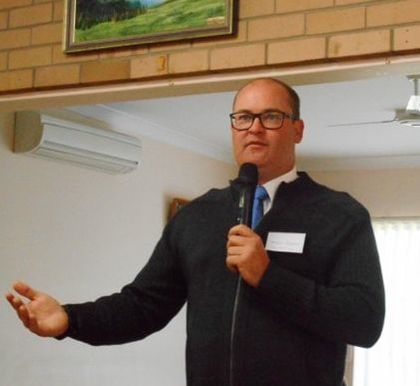
May 2018
William Barrett and Sons is a fourth generation funeral home in the South West of Western Australia. The business was founded by William Barrett who immigrated to Australia from his home in Bantry Bay, Ireland. The Company began as carpenters/builders in Busselton and worked on projects such as the Busselton High School and Caves House. Over time, being carpenters, the company was called upon to build coffins for members of the community that had died. As the community grew, this part of the business grew into funeral arranging and conducting, and William Barrett and Sons gradually left the building industry altogether.
William had four sons, Tom, Frank, Nelson and Wilson. In 1963 Tom and Frank moved to Bunbury and bought the local Funeral Home, William Brittain and Sons, changing the name to William Barrett and Sons. Nelson and Wilson continued to operate the Busselton branch. Over time, William Barrett and Sons has grown to have locations in Harvey and Collie as well.
Currently, Tom’s son, Errol, and grandson, Adrian, run the family business which now covers the entire South West corner of WA. William Barrett and Sons is the only South West member of the Australian Funeral Directors Association (AFDA), of which Adrian is the current Junior Vice President. The AFDA is the only association with physical inspections of premises, equipment and vehicles, as well as mandated training and a code of conduct and code of practice.
William Barrett and Sons is also the only Western Australian member of Selected Independent Funeral Homes, an international invitation only organisation of the World’s leading independent funeral homes.
Adrian is in his 20th year as a funeral director and spent 2 years studying his craft in Toronto, Canada, is a licensed embalmer, previous State President of the AFDA and current National Junior Vice President.
Adrian explained the difference between pre-paying for one’s funeral, and funeral ‘bonds’. The latter are not regarded as an asset, so money invested in a funeral bond will not affect any Centrelink matters as indeed, neither does prepayment for a funeral. However, funeral insurance is quite another matter, and seemingly not recommended as far more can be paid out in premiums than would be required for the actual event. Adrian recommended the making of personal funeral plans, as in choosing one’s photos to be stored ready on a disc so that family are spared having to hunt through boxes of old photos etc. Pre-choosing preferred music and any other desired, personal touches was also suggested.
Adrian further recommended the keeping a folder containing such necessary documents as birth and marriage certificates; Enduring Power of Attorney; passports, funeral plans and wishes, and the all important Will, altogether in a FIREPROOF safe place where family know to be able to access.
All in all a very informative, professional and enlightening discussion.
William Barrett and Sons is a fourth generation funeral home in the South West of Western Australia. The business was founded by William Barrett who immigrated to Australia from his home in Bantry Bay, Ireland. The Company began as carpenters/builders in Busselton and worked on projects such as the Busselton High School and Caves House. Over time, being carpenters, the company was called upon to build coffins for members of the community that had died. As the community grew, this part of the business grew into funeral arranging and conducting, and William Barrett and Sons gradually left the building industry altogether.
William had four sons, Tom, Frank, Nelson and Wilson. In 1963 Tom and Frank moved to Bunbury and bought the local Funeral Home, William Brittain and Sons, changing the name to William Barrett and Sons. Nelson and Wilson continued to operate the Busselton branch. Over time, William Barrett and Sons has grown to have locations in Harvey and Collie as well.
Currently, Tom’s son, Errol, and grandson, Adrian, run the family business which now covers the entire South West corner of WA. William Barrett and Sons is the only South West member of the Australian Funeral Directors Association (AFDA), of which Adrian is the current Junior Vice President. The AFDA is the only association with physical inspections of premises, equipment and vehicles, as well as mandated training and a code of conduct and code of practice.
William Barrett and Sons is also the only Western Australian member of Selected Independent Funeral Homes, an international invitation only organisation of the World’s leading independent funeral homes.
Adrian is in his 20th year as a funeral director and spent 2 years studying his craft in Toronto, Canada, is a licensed embalmer, previous State President of the AFDA and current National Junior Vice President.
Adrian explained the difference between pre-paying for one’s funeral, and funeral ‘bonds’. The latter are not regarded as an asset, so money invested in a funeral bond will not affect any Centrelink matters as indeed, neither does prepayment for a funeral. However, funeral insurance is quite another matter, and seemingly not recommended as far more can be paid out in premiums than would be required for the actual event. Adrian recommended the making of personal funeral plans, as in choosing one’s photos to be stored ready on a disc so that family are spared having to hunt through boxes of old photos etc. Pre-choosing preferred music and any other desired, personal touches was also suggested.
Adrian further recommended the keeping a folder containing such necessary documents as birth and marriage certificates; Enduring Power of Attorney; passports, funeral plans and wishes, and the all important Will, altogether in a FIREPROOF safe place where family know to be able to access.
All in all a very informative, professional and enlightening discussion.
April 2018
Our guest speaker was Jeff Glossop, Senior Financial Adviser from Pennywise Investments, Unit 1, 14 Carey St, Bunbury.
Jeff kept us enthralled with a very lively discussion that covered a very important subject that we better have in order at our time of life. He covered Enduring Power and of Guardianship and why it is important to discuss with family and planning ahead in case a family member needs to go into care. He covered the necessity for well written wills and touched on some of experiences over the years that would have had a happier outcome had the will been registered. He spoke about the importance of having a person as your power of attorney and also spent some time on the importance of choosing an executor. He stressed the importance of a sooner rather than later approach to these matters. He is well aware of how easy it is for us all to put these things off. He came out loud and clear on discussing all these issues with family. He invited members who may have questions or wished to follow up on of the things they may not have understood to contact him through his office anytime. Ph 9791 9113 or Email [email protected]
Our guest speaker was Jeff Glossop, Senior Financial Adviser from Pennywise Investments, Unit 1, 14 Carey St, Bunbury.
Jeff kept us enthralled with a very lively discussion that covered a very important subject that we better have in order at our time of life. He covered Enduring Power and of Guardianship and why it is important to discuss with family and planning ahead in case a family member needs to go into care. He covered the necessity for well written wills and touched on some of experiences over the years that would have had a happier outcome had the will been registered. He spoke about the importance of having a person as your power of attorney and also spent some time on the importance of choosing an executor. He stressed the importance of a sooner rather than later approach to these matters. He is well aware of how easy it is for us all to put these things off. He came out loud and clear on discussing all these issues with family. He invited members who may have questions or wished to follow up on of the things they may not have understood to contact him through his office anytime. Ph 9791 9113 or Email [email protected]
March 2018
Our guest speaker for March was Claire from Magnaflow Brands. Her company is the distributor for the 3G Emergency Alert Pendants.
10 Years ago, her mother had a fall which could have had a different result had she not had the 3G Alert Pendant. The first hour of any emergency is important and falls can happen to anyone and is not dependant on age. In 2014, there were 19,734 cases of accidents in the home and each year this statistic increases by around 10,000 people.
The 3G Emergency Pendant is very portable and has a two-way speech just like a mobile telephone. You can take it on holidays as it is independent of the NBN as is just a 3G mobile phone and uses the 3G network and can receive call from anyone.
The main feature is the SOS Button, where should you have an emergency; hold down the button for 3 seconds and an automatic text message will be sent to your nominated contacts (up to 5) saying “Help Me’ and a map of where you are.
Another feature is the “Fall Down” alert which automatically alerts your contacts should you have a fall. Once again, a map is sent to tell your contacts showing where you are. This is useful for people living alone, joggers, people walking alone or who have to lock up at night – to name a few.
The unit comes fully programmed and is easily rechargeable and waterproof. You would have to decide on a provider as the unit works very similar to a mobile phone and the company is more than happy to assist with this. Or you could utilise a prepaid plan.
Once you have purchased the 3G Emergency Alert Pendant, there are no other ongoing costs
Claire can be contacted on 0429 823 099.
10 Years ago, her mother had a fall which could have had a different result had she not had the 3G Alert Pendant. The first hour of any emergency is important and falls can happen to anyone and is not dependant on age. In 2014, there were 19,734 cases of accidents in the home and each year this statistic increases by around 10,000 people.
The 3G Emergency Pendant is very portable and has a two-way speech just like a mobile telephone. You can take it on holidays as it is independent of the NBN as is just a 3G mobile phone and uses the 3G network and can receive call from anyone.
The main feature is the SOS Button, where should you have an emergency; hold down the button for 3 seconds and an automatic text message will be sent to your nominated contacts (up to 5) saying “Help Me’ and a map of where you are.
Another feature is the “Fall Down” alert which automatically alerts your contacts should you have a fall. Once again, a map is sent to tell your contacts showing where you are. This is useful for people living alone, joggers, people walking alone or who have to lock up at night – to name a few.
The unit comes fully programmed and is easily rechargeable and waterproof. You would have to decide on a provider as the unit works very similar to a mobile phone and the company is more than happy to assist with this. Or you could utilise a prepaid plan.
Once you have purchased the 3G Emergency Alert Pendant, there are no other ongoing costs
Claire can be contacted on 0429 823 099.
February 2018
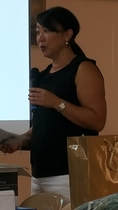
Our guest speaker was Margaret Buswell from Villa Carlotta Travel who gave us an insight into the history of the company.
Villa Carlotta is a business started in Busselton and has been in operation now for 25 years. Her parents bought the Villa Carlotta Hotel in 1979 from Jim and Jan Cummins. Margaret grew up in this wonderful old building with her parents running the Hotel as a business.
In 1991 her parents developed the business into Geographe Coachlines. Her father would pick up guests from the Australind in Bunbury and take them down to stay at the Hotel.
In 1992 Margaret left new job with Arthur Anderson and moved to Bussleton to join the family business. She started the first ever newsletter in March 1993. The tours were loads of fun and as there was no TV, they had to make their own fun with activities such as bingo, bowls etc.
Also, in 1993, major renovations were undertaken. Mainly ensuite bathrooms as up to this point there was only communal bathrooms.
In 1994 they took delivery of a new coach worth $250,000 and by 1995 the building program was complete and then landscaping of the gardens were started. Also, in 1995 the first trip away from Busselton which went to Perth and then onto Broome. It was a great success with a full coach (42 passengers).
In 1997, the Villa celebrated 100 years (1897 to 1997) and in the same year the company took on two employees. The coach tour for that year was a wildflower tour.
In 1998 they introduced a Tasmanian Tour where the passengers flew to Melbourne and connected with a Villa Carlotta coach, crossing the Tasman on the Spirit of ;Tasmania and coached around the island. Also, in 1998 they introduced the Gold Club membership where for an outlay of only $10; for every Villa tour you did, you received a $ value which came off your next trip. This proved most popular.
1999 Saw the first trip to Norfolk Island and by this time the company had expanded to a fleet of 5 coaches with 2 based on the east coast. This proved not to be economical, so now coaches over east and overseas are charted with local drivers.
By 2000 the “office” went from the shed to an office in Busselton, and a web site was created and international cruising was introduced. By 2003 they had a tour explosion and the newsletter became “The Gadabout”. Barry Brown joined the company as CEO and corporatised the business.
By 2006 the Villa hotel started to require major renovations and so with much emotion, it was decided to sell the property. There were 8 “farewell to the Villa tours with lots of emotion from loyal past guests. It was in 2007 that Barry Brown bought into the business and became Managing Director.
However, in 2013 Barry retired and Margaret came back into the business full time as Managing Director and is now the sole owner.
Coming back into the business was a real challenge, however Margaret found she loved the interaction with clients and the bond you form with passengers is something very special.
Next for Villa Carlotta Tours is to open a retail travel agency
Villa Carlotta is a business started in Busselton and has been in operation now for 25 years. Her parents bought the Villa Carlotta Hotel in 1979 from Jim and Jan Cummins. Margaret grew up in this wonderful old building with her parents running the Hotel as a business.
In 1991 her parents developed the business into Geographe Coachlines. Her father would pick up guests from the Australind in Bunbury and take them down to stay at the Hotel.
In 1992 Margaret left new job with Arthur Anderson and moved to Bussleton to join the family business. She started the first ever newsletter in March 1993. The tours were loads of fun and as there was no TV, they had to make their own fun with activities such as bingo, bowls etc.
Also, in 1993, major renovations were undertaken. Mainly ensuite bathrooms as up to this point there was only communal bathrooms.
In 1994 they took delivery of a new coach worth $250,000 and by 1995 the building program was complete and then landscaping of the gardens were started. Also, in 1995 the first trip away from Busselton which went to Perth and then onto Broome. It was a great success with a full coach (42 passengers).
In 1997, the Villa celebrated 100 years (1897 to 1997) and in the same year the company took on two employees. The coach tour for that year was a wildflower tour.
In 1998 they introduced a Tasmanian Tour where the passengers flew to Melbourne and connected with a Villa Carlotta coach, crossing the Tasman on the Spirit of ;Tasmania and coached around the island. Also, in 1998 they introduced the Gold Club membership where for an outlay of only $10; for every Villa tour you did, you received a $ value which came off your next trip. This proved most popular.
1999 Saw the first trip to Norfolk Island and by this time the company had expanded to a fleet of 5 coaches with 2 based on the east coast. This proved not to be economical, so now coaches over east and overseas are charted with local drivers.
By 2000 the “office” went from the shed to an office in Busselton, and a web site was created and international cruising was introduced. By 2003 they had a tour explosion and the newsletter became “The Gadabout”. Barry Brown joined the company as CEO and corporatised the business.
By 2006 the Villa hotel started to require major renovations and so with much emotion, it was decided to sell the property. There were 8 “farewell to the Villa tours with lots of emotion from loyal past guests. It was in 2007 that Barry Brown bought into the business and became Managing Director.
However, in 2013 Barry retired and Margaret came back into the business full time as Managing Director and is now the sole owner.
Coming back into the business was a real challenge, however Margaret found she loved the interaction with clients and the bond you form with passengers is something very special.
Next for Villa Carlotta Tours is to open a retail travel agency
January 2018
Our own Les Bail gave an interesting talk on Albany Cheynes Beach Whale Chasers.
In 1982 one of the last whale boats was acquired and was scuttled in King George Sound, Albany, as a recreational dive site.
Cheynes 1V went onto the hard at Whale World as a major exhibit.
Cheynes 111 for many years was used as a rubbish tip and it took many man hours to clean it up. It was also in a terrible condition with rust.
The engine was removed and is now restored and on display at Whale World.
Cheynes 1V went onto the hard at Whale World as a major exhibit.
Cheynes 11 is aground in Princess Royal Harbour.
When Cheynes 111 left the jetty, it was almost as if it knew its fate as it rolled, yawed, and generally made it very difficult to tow. When it was underway, the sea cocks were opened to facilitate the sinking of the vessel. The ship gradually filled with water and when over her final resting place; a full box of gelignite (40 kilos of gelignite) was used and the ship went down in 38 seconds.
After the ship was successfully sunk, Les was one of the first divers down to see the sunken wreck to discover that fish were already around the wreck. The ship was sunk in 24 meters of water facing South West standing almost upright.
The first to colonise the wreck was brown algae then a hard coral that looked like a little flower. After three months the wreck was covered in algae and at this stage the WA Maritime Museum became interested in the wreck to monitor underwater growth and the fish that take up residence.
When the ship was sunk there was a reason to celebrate and 12 dozen of Plantagenet Port vintage 1982. Then crocks of port for the 10th and 15th anniversary of the sinking.
In 1982 one of the last whale boats was acquired and was scuttled in King George Sound, Albany, as a recreational dive site.
Cheynes 1V went onto the hard at Whale World as a major exhibit.
Cheynes 111 for many years was used as a rubbish tip and it took many man hours to clean it up. It was also in a terrible condition with rust.
The engine was removed and is now restored and on display at Whale World.
Cheynes 1V went onto the hard at Whale World as a major exhibit.
Cheynes 11 is aground in Princess Royal Harbour.
When Cheynes 111 left the jetty, it was almost as if it knew its fate as it rolled, yawed, and generally made it very difficult to tow. When it was underway, the sea cocks were opened to facilitate the sinking of the vessel. The ship gradually filled with water and when over her final resting place; a full box of gelignite (40 kilos of gelignite) was used and the ship went down in 38 seconds.
After the ship was successfully sunk, Les was one of the first divers down to see the sunken wreck to discover that fish were already around the wreck. The ship was sunk in 24 meters of water facing South West standing almost upright.
The first to colonise the wreck was brown algae then a hard coral that looked like a little flower. After three months the wreck was covered in algae and at this stage the WA Maritime Museum became interested in the wreck to monitor underwater growth and the fish that take up residence.
When the ship was sunk there was a reason to celebrate and 12 dozen of Plantagenet Port vintage 1982. Then crocks of port for the 10th and 15th anniversary of the sinking.
November 2017
Our Guest Speaker was David Kerr, General Manager of the Dolphin Discovery Centre.
The Dolphin Discovery Centre is a part of the community and by December 2018 the landscaping for the new centre should be completed. This will enhance the Koombana Bay area with a new adventure playground, kiosk, BBQ facilities. There will also be an auditorium for concerts and volleyball courts. Included in the cost is also a new footbridge, the design of which is a wrecked ship on its side with lighting along the ribs.
The landscaping and the new Dolphin Discovery Centre go hand in hand and the total cost will be in the vicinity of $12.5m. Local indigenous stories were incorporated into the design and the building itself will be very environmentally friendly.
The aquarium will be enlarged with more local sea life and changes will be made to the interpretive centre. Upstairs there will be a fully equipped function centre and restaurant.
The interaction with the dolphins will still take place and of course the eco boat tours.
The business model will be changed to FOC entry to beach however will be a charge to the interpretive centre.
In what is now the boatshed; the back of house aquarium will be housed as it is planned to have as an exhibit the reef eco system around Bunbury with over 450,000 species. They will also be breeding sea animals.
Murdoch University in partnership with the Dolphin Centre have a basic research centre into dolphin behaviour and recently a paper was written on octopus tossing by the dolphins a behaviour not seen elsewhere. (They toss them to make sure they are dead).
Education is a major aim of the Discovery Centre and at a presence is already in secondary schools and in future also high schools.
Main outcomes for the Discovery Centre is improved community facilities and access to the centre; enhanced education; improved tourism entry with a world class interpretive experience with strong destination marketing.
The Dolphin Discovery Centre is the No 1 tourist attraction in our area,
The Dolphin Discovery Centre is a part of the community and by December 2018 the landscaping for the new centre should be completed. This will enhance the Koombana Bay area with a new adventure playground, kiosk, BBQ facilities. There will also be an auditorium for concerts and volleyball courts. Included in the cost is also a new footbridge, the design of which is a wrecked ship on its side with lighting along the ribs.
The landscaping and the new Dolphin Discovery Centre go hand in hand and the total cost will be in the vicinity of $12.5m. Local indigenous stories were incorporated into the design and the building itself will be very environmentally friendly.
The aquarium will be enlarged with more local sea life and changes will be made to the interpretive centre. Upstairs there will be a fully equipped function centre and restaurant.
The interaction with the dolphins will still take place and of course the eco boat tours.
The business model will be changed to FOC entry to beach however will be a charge to the interpretive centre.
In what is now the boatshed; the back of house aquarium will be housed as it is planned to have as an exhibit the reef eco system around Bunbury with over 450,000 species. They will also be breeding sea animals.
Murdoch University in partnership with the Dolphin Centre have a basic research centre into dolphin behaviour and recently a paper was written on octopus tossing by the dolphins a behaviour not seen elsewhere. (They toss them to make sure they are dead).
Education is a major aim of the Discovery Centre and at a presence is already in secondary schools and in future also high schools.
Main outcomes for the Discovery Centre is improved community facilities and access to the centre; enhanced education; improved tourism entry with a world class interpretive experience with strong destination marketing.
The Dolphin Discovery Centre is the No 1 tourist attraction in our area,
September 2017
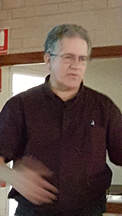
Our guest speaker was Dr Peter Terren, also known as Dr Electric) who is a Tesla forum member. Nicholas Tesla was a Siberian inventor who was a genius and one of the unsung inventors of many familiar electric items today.
Peter became interested in electricity and sparks at aged 12 when he was given a Phillips Electronics Kit by his parents. During High School, he did many projects using electricity and sparks winning several awards. In his youth, he made several items that one prizes; namely a printer plotter, solar panel, an electric car just to name just a few.
After around 20 years he made his first Tesla coil and put it on his web site where the Canadian Discover Chanel did a 15-minute segment on it. Since then he has had 24 TV shoots going all round the world.
With the use of time exposure, he achieves fantastic shots with sparks from the Tesla Coil. Peter describes himself as a “spark artist” (high voltage art).
Lasers are another interest of Peters. Because of his interests he did a year of physics at Uni, however changed to a medical degree. He has had no formal training in electronics and has picked up most of his knowledge from the internet.
He uses his knowledge to make a special display at Christmas, by using time exposure and colour filters. These images go around the world. To see them go to telsadownunder.com.
He has made several Tesla Jacobs Ladders. This is where the sparks go up.
Some other items he discussed are: Ferno Fluid displayed at the Gravity Centre in Gin Gin. This is a fluid with magnets underneath.
Aerogel, which is frozen smoke and a briefcase Tesla Coil. However, the best demonstration was of his car theft deterrent. Which has a Tesla Coil next to a car and the sparks going around the vehicle. Best deterrent around!!
It was a fascinating talk and we unfortunately ran out of time. Please visit Peter’s web site as it is most interesting. www.telsadownunder.com
Below is the car theft deterrent!!!!
Peter became interested in electricity and sparks at aged 12 when he was given a Phillips Electronics Kit by his parents. During High School, he did many projects using electricity and sparks winning several awards. In his youth, he made several items that one prizes; namely a printer plotter, solar panel, an electric car just to name just a few.
After around 20 years he made his first Tesla coil and put it on his web site where the Canadian Discover Chanel did a 15-minute segment on it. Since then he has had 24 TV shoots going all round the world.
With the use of time exposure, he achieves fantastic shots with sparks from the Tesla Coil. Peter describes himself as a “spark artist” (high voltage art).
Lasers are another interest of Peters. Because of his interests he did a year of physics at Uni, however changed to a medical degree. He has had no formal training in electronics and has picked up most of his knowledge from the internet.
He uses his knowledge to make a special display at Christmas, by using time exposure and colour filters. These images go around the world. To see them go to telsadownunder.com.
He has made several Tesla Jacobs Ladders. This is where the sparks go up.
Some other items he discussed are: Ferno Fluid displayed at the Gravity Centre in Gin Gin. This is a fluid with magnets underneath.
Aerogel, which is frozen smoke and a briefcase Tesla Coil. However, the best demonstration was of his car theft deterrent. Which has a Tesla Coil next to a car and the sparks going around the vehicle. Best deterrent around!!
It was a fascinating talk and we unfortunately ran out of time. Please visit Peter’s web site as it is most interesting. www.telsadownunder.com
Below is the car theft deterrent!!!!
August 2017
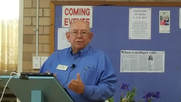
Our guest speaker this month is Peter Snow from the Jaycees Committee.Peter was very much involved in the set-up of the Albany Whale World and gave an excellent talk on the formation of Whale World.
Albany whaling was in dire straits and after the auction of assets, they were stuck with 3 whaling ships. Pone boat was donated to Peter’s charity and put on the Swan River at East Fremantle, however the costs were too high. So therefore, it stayed in Albany at the whaling station.
The Green family gifted the assets left over from the auction to aid the formation of the existing Whale World.
Peter was fortunate enough to meet up with Richard Ellis (a world leading authority on whales and an artist), based in New York. Richard Ellis offered the original artwork (106 paintings) of whale stamps minted in the US, to Whale World for $250,000. This money was donated by Kevin Parry and so the Kevin Parry Gallery was formed at Whale World.
In 1996 Les Bail became associated with Whale World and ended up staying for 13 years. During his tenure, Les oversaw the restoration of 2 ships, one engine plus the buildings and surrounds.
It is a credit to Les that Whale World is now heritage listed.
Via a Lottery West grant of $1.1 million, the old oil tanks were converted into theatres, the breakwater and jetty was restored.
Whale World has won 4 awards for tourism and restoration.
The current project is for a bio diversity park featuring West Australian wildflowers, with six ponds which will be part of the eco water processing unity which will take the water from the ponds to drinking water. There will be a board walk through the area, with 130 animals on site. The area will also have an amphitheatre for cultural events.
Whale World brings $40 million to the local economy per annum, employs 26 people plus a fleet of volunteers and has 40,000 to 72,000 visitors in a year.
Albany whaling was in dire straits and after the auction of assets, they were stuck with 3 whaling ships. Pone boat was donated to Peter’s charity and put on the Swan River at East Fremantle, however the costs were too high. So therefore, it stayed in Albany at the whaling station.
The Green family gifted the assets left over from the auction to aid the formation of the existing Whale World.
Peter was fortunate enough to meet up with Richard Ellis (a world leading authority on whales and an artist), based in New York. Richard Ellis offered the original artwork (106 paintings) of whale stamps minted in the US, to Whale World for $250,000. This money was donated by Kevin Parry and so the Kevin Parry Gallery was formed at Whale World.
In 1996 Les Bail became associated with Whale World and ended up staying for 13 years. During his tenure, Les oversaw the restoration of 2 ships, one engine plus the buildings and surrounds.
It is a credit to Les that Whale World is now heritage listed.
Via a Lottery West grant of $1.1 million, the old oil tanks were converted into theatres, the breakwater and jetty was restored.
Whale World has won 4 awards for tourism and restoration.
The current project is for a bio diversity park featuring West Australian wildflowers, with six ponds which will be part of the eco water processing unity which will take the water from the ponds to drinking water. There will be a board walk through the area, with 130 animals on site. The area will also have an amphitheatre for cultural events.
Whale World brings $40 million to the local economy per annum, employs 26 people plus a fleet of volunteers and has 40,000 to 72,000 visitors in a year.
July 2017 There was no guest speaker for this month as we celebrated our 25th year. See Activities for photos.
June 2017
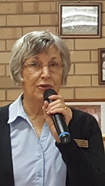
Guest speaker for June was Jan Akaczowek from Hands Up for Kids.
Jan was born in 1946 in Kalgoorlie (East Coolgardie) and was there until high school. She married a man who was very involved in mining and through his mining career, they moved around Australia a fair bit; ending back in Kalgoorlie. Back in Kalgoorlie, Jan became the manager of the Tourist Bureau for the goldfields. Once again, they moved, this time to Manjimup where Jan through her expertise became the manager of the Manjimup Tourist Bureau which she said was very rewarding. It was in Manjimup that she met Jan Peterson – a meeting that was to prove instrumental in her role today.
Jan and her family moved to Bunbury 15 years ago and Jan worked at the Entertainment Centre where she once again ran into Jan Peterson. Jan Peterson is in Partnership Broking; which means they try to get the best deal they can for a program – mainly assisting young people to obtain jobs. Jan found out that children were leaving school with little or no literacy skills. Ms Peterson put into place (along with other principals) a program for schools whereby if they could get volunteers to listen to children read it would improve literacy.
In 2012 a pilot program was set up; first with Withers School and then 3 schools around Australind. Now there are 17 schools with 165 state primary schools throughout the greater Bunbury and Brunswick area, with Margaret River soon to participate.
The program is run by people from the local community, who give 1 hour per week at their local school and with consistency of listening to the children – it turns attitudes around. Studies show that if a child cannot read by the time they are 9, they will struggle through life.
Volunteers need no special training, just the time, interest and commitment and as a volunteer, you have all the rewards without the problems that a teacher has. In fact, if there is a problem – you go to the teacher in every case.
All volunteers go through an induction and must have a Working with Children Certificate, plus be of good character backed up by references.
In 2016 the volunteers donated 3,851 hours which equates to a dollar value of $125,352 to local schools. There are usually 10 volunteers per school, the Maidens have 17.
The main aim is to help schools to raise literacy levels.
There is no funding from the Government as schools and business supply the monitory portion of the program’
Volunteers are always welcome!!!!!
Jan was born in 1946 in Kalgoorlie (East Coolgardie) and was there until high school. She married a man who was very involved in mining and through his mining career, they moved around Australia a fair bit; ending back in Kalgoorlie. Back in Kalgoorlie, Jan became the manager of the Tourist Bureau for the goldfields. Once again, they moved, this time to Manjimup where Jan through her expertise became the manager of the Manjimup Tourist Bureau which she said was very rewarding. It was in Manjimup that she met Jan Peterson – a meeting that was to prove instrumental in her role today.
Jan and her family moved to Bunbury 15 years ago and Jan worked at the Entertainment Centre where she once again ran into Jan Peterson. Jan Peterson is in Partnership Broking; which means they try to get the best deal they can for a program – mainly assisting young people to obtain jobs. Jan found out that children were leaving school with little or no literacy skills. Ms Peterson put into place (along with other principals) a program for schools whereby if they could get volunteers to listen to children read it would improve literacy.
In 2012 a pilot program was set up; first with Withers School and then 3 schools around Australind. Now there are 17 schools with 165 state primary schools throughout the greater Bunbury and Brunswick area, with Margaret River soon to participate.
The program is run by people from the local community, who give 1 hour per week at their local school and with consistency of listening to the children – it turns attitudes around. Studies show that if a child cannot read by the time they are 9, they will struggle through life.
Volunteers need no special training, just the time, interest and commitment and as a volunteer, you have all the rewards without the problems that a teacher has. In fact, if there is a problem – you go to the teacher in every case.
All volunteers go through an induction and must have a Working with Children Certificate, plus be of good character backed up by references.
In 2016 the volunteers donated 3,851 hours which equates to a dollar value of $125,352 to local schools. There are usually 10 volunteers per school, the Maidens have 17.
The main aim is to help schools to raise literacy levels.
There is no funding from the Government as schools and business supply the monitory portion of the program’
Volunteers are always welcome!!!!!
May 2017
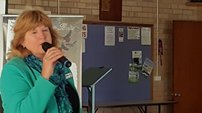
Our Guest speaker was Linda J Bettaney an authoress who was born in Rolystone into a pioneering family who have farmed their land since 1901 and lived in the area since 1895. Linda was a teacher for over 30 years in various schools within W.A. When she is not writing, Linda is the editor of a much-loved community magazine; The Rolystone Courier.
Her passion is telling Australian stories and obtains a lot of her inspiration from seniors who all have stories to tell. She encourages all to write their own story however, the trick is knowing what to leave out.
Linda grew up on the family property that has a stream running through it and that stream runs into Auraluen National Park and still lives there.
Her first novel came about from her grandfather’s diary which was pretty boring, so you had to read between the lines. Her book, The Apple Core Wars is about 2 boys that hated one another and spend most of their time throwing rotten fruit at one another. Charlie Parkin one of seven brothers (the Parkin boys cricket team is still famous in Rolystone) and his enemy Jack Bellamy, both went onto serve in WW2 in the Middle East in the same battalion. They were both captured and interned in the same POW camp which they survived and became great mates. The book does have a happy ending!
Her 2nd book, Wishes for Starlight, is about an aboriginal boy who was born a deaf mute in 1889 and was abandoned. He was found by 3 white children in a chook pen in 1901 who decided to keep him – for 30 years. The book deals with serious issues about the treatment of aboriginals 1905 – 1930.
Linda’s 3rd book The Secrets Mothers Keep is a story about her husband’s family. It is a chilling story of murder, rape and violence. It was a secret that only came to light 3 years ago and (God bless Google) Linda Googled Wubin Murder and the full story came to light. It is about a murder committed 85 years ago (1928) in Wubin. It is a story that has violence but also shows the courage and resilience of people and how when the chips are down community spirit will come to the fore. The book also has the story from the murder’s perspective.
Linda’s talk was entraining as well as uplifting and she can be contacted by email on [email protected] or her web site is www.lindasbooks.com.au .
Her passion is telling Australian stories and obtains a lot of her inspiration from seniors who all have stories to tell. She encourages all to write their own story however, the trick is knowing what to leave out.
Linda grew up on the family property that has a stream running through it and that stream runs into Auraluen National Park and still lives there.
Her first novel came about from her grandfather’s diary which was pretty boring, so you had to read between the lines. Her book, The Apple Core Wars is about 2 boys that hated one another and spend most of their time throwing rotten fruit at one another. Charlie Parkin one of seven brothers (the Parkin boys cricket team is still famous in Rolystone) and his enemy Jack Bellamy, both went onto serve in WW2 in the Middle East in the same battalion. They were both captured and interned in the same POW camp which they survived and became great mates. The book does have a happy ending!
Her 2nd book, Wishes for Starlight, is about an aboriginal boy who was born a deaf mute in 1889 and was abandoned. He was found by 3 white children in a chook pen in 1901 who decided to keep him – for 30 years. The book deals with serious issues about the treatment of aboriginals 1905 – 1930.
Linda’s 3rd book The Secrets Mothers Keep is a story about her husband’s family. It is a chilling story of murder, rape and violence. It was a secret that only came to light 3 years ago and (God bless Google) Linda Googled Wubin Murder and the full story came to light. It is about a murder committed 85 years ago (1928) in Wubin. It is a story that has violence but also shows the courage and resilience of people and how when the chips are down community spirit will come to the fore. The book also has the story from the murder’s perspective.
Linda’s talk was entraining as well as uplifting and she can be contacted by email on [email protected] or her web site is www.lindasbooks.com.au .
April 2017
Guest speaker was John Stachlewski who spoke about the successful growing of succulents. He belongs to a group called “Succulents and Cacti” which meet once a month at the Salvation Army Hall.
His talk covered:
Some succulents have a milky sap which is dangerous and can cause blindness if it gets into the eyes.
Stem succulents are prickly with no leaves. Leaf succulents are soft, jelly like and juicy and are usually slow growing.
Root succulents are very rare, slow growing and survive long drought.
Myths:
Euphorbias can grow up to 5 metres high and can be extremely dangerous to remove. It has a very toxic milky sap. You should there consider height and shape when planting. Water only when dry and always have good drainage.
Common Pests:
His talk covered:
- Description of Succulents
- Families of Succulents
- Myths about Succulents
- Planting of Succulents
- Caring for Succulents
- Pests affecting Succulents
- Propagation of Succulents.
- Art Work – creative containers.
Some succulents have a milky sap which is dangerous and can cause blindness if it gets into the eyes.
Stem succulents are prickly with no leaves. Leaf succulents are soft, jelly like and juicy and are usually slow growing.
Root succulents are very rare, slow growing and survive long drought.
Myths:
- Will grow anywhere, don’t worry about soil.
- Rarely or never need watering.
- They all like full sun
- Cold weather will not hurt them.
- Pests and diseases won’t attach succulents.
- You can’t kill a succulent.
Euphorbias can grow up to 5 metres high and can be extremely dangerous to remove. It has a very toxic milky sap. You should there consider height and shape when planting. Water only when dry and always have good drainage.
Common Pests:
- Red Spider
- Mealy Bugs
- Snails and Slugs
- Aphids
- White flies
- Scale
March 2017
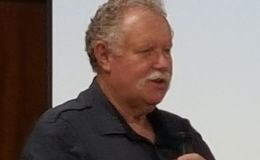
Guest speaker was Iain Farmer whose passion is flying, aircraft and his wife Debbie. Iain was born in Donnybrook and has been in conservation in one form or another all his working life.
He has been involved in Arial fire spotting for the past 40 years. In the 60’s and 70’s fire spotting was done by fire towers which were built in the 20’s and 30’s. In 1972 he participated in a 2-week trial with aircraft doing fire spotting in the Pemberton area which was so successful, that it continued for all of 1972 and 1973. The main reason it was so successful is that from an aircraft the pilot can look down to the base of a fire, which cannot be done from a tower.
In the fire season of 1976/77 the WA government decided to use aircraft full time. The number of towers in use was reduced to 4 and by late 70’s there were 21 pilots and 13 spotter panes in use. This has grown to now there are 250 seasonal pilots, many of which go onto become commercial pilots.
Iain started off flying a Cessna 150 which were poor performers on hot days. In 1978, Piper Clubs were introduced then in the 90’s the Australian Eagle and 1999 the American Scout aircraft.
In the last few years Av Gas fuel prices have gone through the roof which has resulted in the reintroduction of 11 of the fire towers were recommissioned and the circuits reduced to 5.
Pilots are restricted in the number of hours they can fly (2.5 to 3 hours) and in the season, are on a 20-minute call out.
Air attack supervision (water bombers) have 2 spotter planes which advise where the bomber is to go. Bombers usually drop foam except where is it an environmentally sensitive area.
Bunbury is in the Wellington circuit. Each circuit takes about 60 minutes to fly and is around 110 nautical miles. Visibility is usually around 15 nautical miles and the planes fly from 2,500 to 6,500 ft.
Before each flight, a schedule is given to the pilots plus a smoke report. This used to in a form format however now it is all on an IPad which is fixed to the aircraft. Reports are instantaneous. The future of fire spotting is the use of drones.
It was a very interesting talk and unfortunately, we ran out of time. Not every day that you meet someone whose passion is also his occupation.
He has been involved in Arial fire spotting for the past 40 years. In the 60’s and 70’s fire spotting was done by fire towers which were built in the 20’s and 30’s. In 1972 he participated in a 2-week trial with aircraft doing fire spotting in the Pemberton area which was so successful, that it continued for all of 1972 and 1973. The main reason it was so successful is that from an aircraft the pilot can look down to the base of a fire, which cannot be done from a tower.
In the fire season of 1976/77 the WA government decided to use aircraft full time. The number of towers in use was reduced to 4 and by late 70’s there were 21 pilots and 13 spotter panes in use. This has grown to now there are 250 seasonal pilots, many of which go onto become commercial pilots.
Iain started off flying a Cessna 150 which were poor performers on hot days. In 1978, Piper Clubs were introduced then in the 90’s the Australian Eagle and 1999 the American Scout aircraft.
In the last few years Av Gas fuel prices have gone through the roof which has resulted in the reintroduction of 11 of the fire towers were recommissioned and the circuits reduced to 5.
Pilots are restricted in the number of hours they can fly (2.5 to 3 hours) and in the season, are on a 20-minute call out.
Air attack supervision (water bombers) have 2 spotter planes which advise where the bomber is to go. Bombers usually drop foam except where is it an environmentally sensitive area.
Bunbury is in the Wellington circuit. Each circuit takes about 60 minutes to fly and is around 110 nautical miles. Visibility is usually around 15 nautical miles and the planes fly from 2,500 to 6,500 ft.
Before each flight, a schedule is given to the pilots plus a smoke report. This used to in a form format however now it is all on an IPad which is fixed to the aircraft. Reports are instantaneous. The future of fire spotting is the use of drones.
It was a very interesting talk and unfortunately, we ran out of time. Not every day that you meet someone whose passion is also his occupation.
February 2017
Guest speaker was once again our own Dorothy Bail who gave us an abbreviated run down on her life story. She was born in Bunbury the eldest of 3 children, and as a toddler moved to Donnybrook as her father took up dairy farming. At around 8 years she moved to Narrikup and attended the Mount Barker primary school. She left school early and went to work as a hairdresser’s apprentice in Albany and had to board in Albany. She finished her apprenticeship, met and married Les Bail and had children. She decided to go back to work for a short while and stayed 6 years at the same place. Dorothy worked in hairdressing in Albany for many years and then due to ill health retired. Her husband Les had a dive shop and charter boat business which was quite busy (3 trips a day whale watching). She found that she created a monster as in the beginning of the business she used to make biscuits for the charters which grew and so did the amount of biscuits she had to make. Dorothy has always been interested in photography and in 1986 entered a competition which she won. She decided to join the club and for a long time she was responsible for the newsletter and Less was President. In 1996 the camera club hosted a convention in Albany in an old shearing shed nestled in the Stirling Ranges. To thank the farmer Dorothy did a presentation of the farm over the four seasons (12 months) which was well received. They moved to Bunbury when Dorothy inherited a house built in 1927. Recently she was instrumental in organising the Clifton family reunion at Alverstoke for over 400 descendants of the first settlers.
Ian Farrell entertained us with some bush poetry which was as always well received.
January 2017
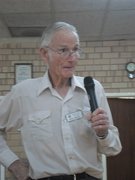
Our Guest Speaker was one of our own members - Mike Reeve who being the gentleman that he is, gave us a surprising discourse on ladies underwear.
He started by describing how in the "olden days" underwear was made of calico and held up with a drawstring tied in a bow. Gradually glamour came into the equation with the invention of elastic. In the early days elastic was not reliable, but now life is very different with stretch fabric. Stories of mishaps with ladies undergarments had us rolling in the isles.
Corsets were popular in the olden days which laced up at the back. Corsets were designed to hold in the bulges and he told a very funny story here with the comment that thank goodness we have progressed.
As a rule, most mammals do not develop breasts unless they are suckling young; however the human female was designed differently - and develop breasts at puberty. Mike commented that he was sure breasts were designed to attract the male of the species. The cleaverage in between this interesting development is very intriguing, and as a male, you had to wonder what was there. (Mike had us all laughing at a story he told here).
Bikinis were developed after World War 11 and names after an Atoll in the Marshall Islands where the US tested the Atomic Bomb. Once again we were in stitches with a story he told about the bikini.
Various members added to the discussion on ladies underwear.
It was interesting as well as very funny to obtain a man's perspective on "unmentionables".
He started by describing how in the "olden days" underwear was made of calico and held up with a drawstring tied in a bow. Gradually glamour came into the equation with the invention of elastic. In the early days elastic was not reliable, but now life is very different with stretch fabric. Stories of mishaps with ladies undergarments had us rolling in the isles.
Corsets were popular in the olden days which laced up at the back. Corsets were designed to hold in the bulges and he told a very funny story here with the comment that thank goodness we have progressed.
As a rule, most mammals do not develop breasts unless they are suckling young; however the human female was designed differently - and develop breasts at puberty. Mike commented that he was sure breasts were designed to attract the male of the species. The cleaverage in between this interesting development is very intriguing, and as a male, you had to wonder what was there. (Mike had us all laughing at a story he told here).
Bikinis were developed after World War 11 and names after an Atoll in the Marshall Islands where the US tested the Atomic Bomb. Once again we were in stitches with a story he told about the bikini.
Various members added to the discussion on ladies underwear.
It was interesting as well as very funny to obtain a man's perspective on "unmentionables".
December 2016
|
November 2016
Our Guest speaker was Don Wass on Beekeeping. Don has been keeping bees for many years and is Patron of the Exmouth Beekeeping Society as well as being very involved with South West Beekeeping.
He started his talk by showing us some of the equipment he uses. The smoker quietens the bees down (they think a bushfire is coming, so they fill up with honey and depart). The actual hive has frames that are made from beeswax.
To get started, you can buy a box of bees, catch a swarm or split a hive. The base of the hive is a pollen trap. Bees go into the hive via the pollen trap where the pollen is caught in a tray in the trap. Each day the beekeeper collects the pollen. The box (hive) with frames of beeswax has a mesh trap to keep the queen bee below, and then a top is put on whole hive.
Don told us stories of some interesting people he has met through the Brunswick Beekeeping Club and also of his time keeping bees in Exmouth.
Why keep bees:
Honey Wax Propaluis (Cosmetics) Modern medicine Jarrah honey is as good as Maluka. Pollinating Export of bees mainly to the USA
Bees have several pests; wax moth, hive beetle and varover (? Small mites that get onto bees and live off the juices of the bee) mite to name a few. There bees need sentinel hives with a pad that slides under the frame of the hive and the bees will chase pests onto the pad.
Moving a hive. Bees do a bee dance (Don demonstrated this too much laughter) that tells other bees where there is a honey source. They always know where a hive is.
Harvesting: You take the frames from the hive and cut off the top wax and put this into centrifuge to extract the honey.
Genetics. From Queen Bee to drone worker. The queen starts off as an egg; the difference the queen is fed royal jelly. The new queen hatches and kills any other contenders as only one queen is required. After 20 days she goes on a maiden flight and she mates (15 times) with drones. The queen has complete control over her body and can choose to lay infertile eggs. She lays 15 eggs a day for around 15 years.
Workers start off as an egg and when they mature the first thing they do is clean their cells. They are hatched knowing their place in the hive and what work they are assigned to. Workers gather honey and keep the hive clean.
It was a fascinating insight into the keeping of bees and how bees are integral to the health of the environment. Australia is relatively disease free (the bees that is) however America is in deep trouble. The best way to keep bees happy if to have diverse eco system and have a garden or crops of varying types.
October 2016
Guest speaker was Lorraine English from Consumer Protection.
Scams – Consumer Protection is there to help protect you and every Wednesday morning Debbie Button does a talk on local ABC radio with the latest scams and advice on how to protect yourself. Anyone can be involved in a scam and seniors are most vulnerable. 1 in 20 people in Australia lose money to scammers and 9.8 million scammed from WA residents last year. This was from just 456 people. Lot of scams go unreported due to various reasons. Scamming is part of the Organised Crime section of the WA Police and is called fraud. The police work closely with Australia Post and every year hundreds and thousands of scam mail is ceased. Companies get fake invoices and in very large organizations, they are just paid.
Emails – do not click to open an email if it is to verify records from any source. This is just so a virus can obtain all your accounts and personal details. Door to door selling has its own rules and if in doubt call Consumer Protection (we love your calls).
Face Book –never respond to anyone you do not know.
Money laundering – this is where you are asked to pay money from a third source into your account. Please advise your bank and Consumer Protection. If selling goods (i.e. eBay) have a seperate bank account or PayPal.
Common Scams: Financial windfall (if you have not bought a lottery ticket in Uganda you have not won) Iterant door to door salespeople (art, roof repairs, driveway repairs etc.) Fake researchers, help re email (seems like it is from Microsoft), Phishing for information (check your email settings for junk mail) Do not call register. This is for life and you can do for multiple numbers however not for international numbers. You can also register your fax number. Most telephone scammers are on a 02 or 03 number and if you do not recognise the number, don’t answer. Protect your money – beware of wire transfers. Make sure your passwords are secure. Online banking: If the web address starts with HTTPS (S=secure) it is OK. There can also be a picture of a lock on the site to show it is secure.
Lorraine gave each member a very handy pack from Consumer Protection on scams.
September 2016
Our guest speaker for this month was Elaine Hill who as a teenager participated in one of the early Rotary Exchange programs. This is her story.
In 1975 Elaine was selected to be a Rotary exchange student. She left her home town of Harvey and travelled to Holton Kansas, a small mid-western town in the USA. It was a bit of a culture shock as when she arrived in Holton, it was 00 and snow was falling. As Elaine was 18 years she didn’t have to attend school full time, so she worked half a day in a beauty salon (hairdressers). In those days, people in the US knew hardly anything of Australia, especially in mid-western USA, so it was a learning curve for both the people of Holton and Elaine. She was able to give people an insight into life in Australia and took with her lots of slides to show our rich diversity of both land and people. She did however, use the good old Aussie “pulled your leg” by telling students that she rode to school on a kangaroo – some even believed her. During her time in Holton, she stayed with 6 families in 12 months and she found that the diet was very different. For instance on toast everything was very sweet and as a consequence she craved vegemite. The food was very rich with large portions and lots of take always which meant she ended up putting on weight. During her time in the US she learnt to water ski, and hiked through the Rocky Mountains in Colorado up to 15,000 feet (Pikes Peak). In the 12 months that she was there she spoke to her parents only 3 times as this was pre-internet days. When she arrived home it was a bit of a shock as for 12 months she had been the centre of attention, but this was all put aside as she concentrated on a career in the travel industry. It was on travel agents educational that she met her husband who was a pilot in the Singaporean Air force and she lived in Singapore for 4 years working in the Australian Embassy and had two children. Unfortunately Elaine found the cultural difference too much and moved back to Australia allowing her children to be educated in Australia. Skipping forward to today, she reconnected with her friends in the USA through face book and attended a reunion of the class of ’76 in Holton Kansas. She was fortunate enough to stay with one of her old “mothers” while there. The reunion was fantastic and it was just like they were 18 again. After visiting Holton, Elaine went onto New York, England (Cornwell), Paris, Hong Kong and Singapore completing a memorable journey visiting friends in these destinations. Elaine’s talk was informative and the Rotary Exchange Program is a worthy enterprise for the confidence that it installs in the participants if nothing else.
August 2016
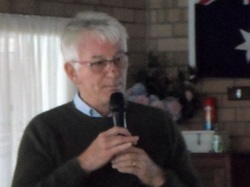
Guest speaker for August was Tony Snelling from the Water Corporation who spoke about the long term planning regarding water in the future.
The Department of Water (DoW) owns the water in Western Australia and licences the water out to various organisations such as the Water Corporation
The DoW sets up a master plan and from that puts up a licence situation to: 1.Farmers, 2. Mining, and 3. Public. The Water Corporation, being one of the licensees; also has a plan to the year 2060.
The Water Corporation’s 50year challenge provides for a) drier climate, b) Population and c) environmental impact. .
Water not going into the dams started in the 1970’s and by 2000 had dropped off dramatically with 2015 the worst year yet for dam run off. Groundwater started to be used in the 1970’s and by the year 2000 DoW refused further use of groundwater reserves.
The saviour was desalination, the first one being in Kwinana. The plant at Binningup supplies water from Harvey up and out as far as Kalgoorlie. However even with desalination, there is a short fall and the extra comes from waste water refill (5%). So this means the dams no longer count as the water mainly comes from desalination with any excess poured into existing dams.
In Western Australia, we are using domestically less water now than in 1985. We need 310GL and the result was that 48GL excess flowed into Wellington Dam.
It was interesting to note that even though we are using less water now, around 500 people in the Eaton/Australind area received notification or a visit advising that they were using too much water. The Water Corporation will help rectify the problem if they can.
We are fortunate to have the Yarragadee Aquifer, which is the oldest of the aquifers in WA. Water flows down from the Darling Range and takes 30,000 years for you to be able to access as drinking water.
In the South West most water is used in farming and commercial (53%) with 8% from the aquifers.
Our area is becoming drier so there may be a need for a further desalination plant in the South West. In the Australind/Eaton area, water usage has dropped by 107KL p.a. (34%) which means we will not need a new source until around 2060.
A recent survey revealed that water needs was most important (78%) so therefore we have to:
The Department of Water (DoW) owns the water in Western Australia and licences the water out to various organisations such as the Water Corporation
The DoW sets up a master plan and from that puts up a licence situation to: 1.Farmers, 2. Mining, and 3. Public. The Water Corporation, being one of the licensees; also has a plan to the year 2060.
The Water Corporation’s 50year challenge provides for a) drier climate, b) Population and c) environmental impact. .
Water not going into the dams started in the 1970’s and by 2000 had dropped off dramatically with 2015 the worst year yet for dam run off. Groundwater started to be used in the 1970’s and by the year 2000 DoW refused further use of groundwater reserves.
The saviour was desalination, the first one being in Kwinana. The plant at Binningup supplies water from Harvey up and out as far as Kalgoorlie. However even with desalination, there is a short fall and the extra comes from waste water refill (5%). So this means the dams no longer count as the water mainly comes from desalination with any excess poured into existing dams.
In Western Australia, we are using domestically less water now than in 1985. We need 310GL and the result was that 48GL excess flowed into Wellington Dam.
It was interesting to note that even though we are using less water now, around 500 people in the Eaton/Australind area received notification or a visit advising that they were using too much water. The Water Corporation will help rectify the problem if they can.
We are fortunate to have the Yarragadee Aquifer, which is the oldest of the aquifers in WA. Water flows down from the Darling Range and takes 30,000 years for you to be able to access as drinking water.
In the South West most water is used in farming and commercial (53%) with 8% from the aquifers.
Our area is becoming drier so there may be a need for a further desalination plant in the South West. In the Australind/Eaton area, water usage has dropped by 107KL p.a. (34%) which means we will not need a new source until around 2060.
A recent survey revealed that water needs was most important (78%) so therefore we have to:
- Adapt to change
- Realise that there is no single solution as we don’t know what will happen in the future.
- Have to become more conscious of water usage.
- We cannot rely on dams as we are not having the rain fall to have the run off.
- Desalination is the way of the future
- Reuse waste water
July 2016
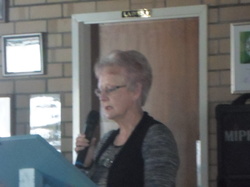
Guest speaker was our own Kaye Scott. Kaye told us about her family history and her life story.
Kaye’s ancestors came out on the ship “Trusty” in 1842 and took up land in Brunswick. Kaye’s family stayed in the area and Kaye grew up in Brunswick in the original stone and mud brick home which had shingles on the roof. The house was over 100 years old.
Kaye was the eldest of 3 and went to school in Brunswick and High School in Bunbury. She married Roy and had 2 children (Kelly and Craig). Roy became a Police Officer and was transferred around regional WA. (They have been married for 50 years)
While Roy was stationed in Perth, Kaye coached netball at Thornlie and completed a Public Speaking course. She also helped with the marketing and sales of the Hotham Valley Railway.
Roy was transferred to York and they purchased a property there and stayed for 8 years. While in York Kaye was involved with the CWA and Tidy Towns Association. She was also very involved with Rotary Women and raised money for stem cell research (2m raised in Australia) and SIDS.
She was involved in amateur theatricals and through FESA, trained in Emergency Management.
Kaye and Roy moved to Australind 2 years ago. She now playes bowls at Brunswick, loves doing crosswords and writing poetry.
Kaye read a poem she wrote about the recent fires in Yarloop and surrounds. The poem has been reproduced in full below.
PEOPLE WHO CARE
Life in the country is the best yet
Space all around, blue skies you bet.
Hills of greem, valleys with colour everywhere
Roads wind along the ridge with wildlife there.
Villages with families loving this life
Away from the cities with all their strife
It's summer, the sounds of cicadas ring all around
Birds singing as they fly up from the ground
Then on the hill in the distance we see
A danger heading our way
With smoke all around as flames make night into day
We need to gather some things that we love and cherish
Then leave our home, escape the danger as not to perish
As we run to our car with pets in hand
Many of our neighbours and friends fleeing this land
Gasping as we run, eyes filled with tears
Just the sound of its roar ringing in our ears
Have we left it too late to escape this hell?
People screaming their cries of help we can tell
It's passed in minutes that seem like an eternity
We pray be spared but reality shows pity
There's death everywhere many animals failed to escape
We need to be patient and just sit and wait
With trees and shrubs lost who is to blame
Then there's our home gone up in flame
The firefighters fought this blaze for many days
They need to be honoured for their gallant ways
But our lives are saved so we can go on
We love this country with people who care
They will help us rebuild and make it easier to bare
Thank you all for your love and understanding
The help you gave was quite astounding.
Kaye Scott
Kaye’s ancestors came out on the ship “Trusty” in 1842 and took up land in Brunswick. Kaye’s family stayed in the area and Kaye grew up in Brunswick in the original stone and mud brick home which had shingles on the roof. The house was over 100 years old.
Kaye was the eldest of 3 and went to school in Brunswick and High School in Bunbury. She married Roy and had 2 children (Kelly and Craig). Roy became a Police Officer and was transferred around regional WA. (They have been married for 50 years)
While Roy was stationed in Perth, Kaye coached netball at Thornlie and completed a Public Speaking course. She also helped with the marketing and sales of the Hotham Valley Railway.
Roy was transferred to York and they purchased a property there and stayed for 8 years. While in York Kaye was involved with the CWA and Tidy Towns Association. She was also very involved with Rotary Women and raised money for stem cell research (2m raised in Australia) and SIDS.
She was involved in amateur theatricals and through FESA, trained in Emergency Management.
Kaye and Roy moved to Australind 2 years ago. She now playes bowls at Brunswick, loves doing crosswords and writing poetry.
Kaye read a poem she wrote about the recent fires in Yarloop and surrounds. The poem has been reproduced in full below.
PEOPLE WHO CARE
Life in the country is the best yet
Space all around, blue skies you bet.
Hills of greem, valleys with colour everywhere
Roads wind along the ridge with wildlife there.
Villages with families loving this life
Away from the cities with all their strife
It's summer, the sounds of cicadas ring all around
Birds singing as they fly up from the ground
Then on the hill in the distance we see
A danger heading our way
With smoke all around as flames make night into day
We need to gather some things that we love and cherish
Then leave our home, escape the danger as not to perish
As we run to our car with pets in hand
Many of our neighbours and friends fleeing this land
Gasping as we run, eyes filled with tears
Just the sound of its roar ringing in our ears
Have we left it too late to escape this hell?
People screaming their cries of help we can tell
It's passed in minutes that seem like an eternity
We pray be spared but reality shows pity
There's death everywhere many animals failed to escape
We need to be patient and just sit and wait
With trees and shrubs lost who is to blame
Then there's our home gone up in flame
The firefighters fought this blaze for many days
They need to be honoured for their gallant ways
But our lives are saved so we can go on
We love this country with people who care
They will help us rebuild and make it easier to bare
Thank you all for your love and understanding
The help you gave was quite astounding.
Kaye Scott
June 2016
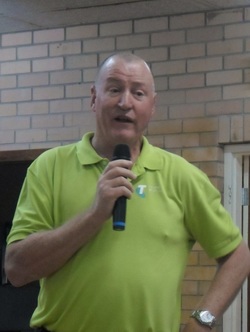
Guest speaker was Syd Cobban with his assistant Jess. Both are employees of Telstra and talked on the roll out of the NBN and what it means to us.
NBN is the old Telecom and is now laying cable around Australia or buying up existing networks. The NBN Network will be completed by 2020 (or the majority of it), however the date of connection will depend on where you live. Bunbury is to be connected now and some of Eaton by the end of June, with Australind in two stages. The first by 30 June the second by 2 September.
Connection is at present (depends on which government party gets in) by fibre optic to node and copper to the residence with fixed wireless in country areas. There is also satellite which was launched on 1 October 2015 and commissioned in April 2016.
Technology. If you have a home phone and or internet you must connect through you provider. If you have mobile only you do not have to connect unless you want better internet access.
Many will have to upgrade old telephones (over 20 years old) and lifestyle villages need special consideration. Eg. Medi Alert
There will no longer be a fixed line fee and you will have “bundles” through your provider.
You will need to ask to be connected through your provider – it will not happen automatically.
It was very informative on the NBN and got rid of all the myths and misinformation surrounding the NBN.
NBN is the old Telecom and is now laying cable around Australia or buying up existing networks. The NBN Network will be completed by 2020 (or the majority of it), however the date of connection will depend on where you live. Bunbury is to be connected now and some of Eaton by the end of June, with Australind in two stages. The first by 30 June the second by 2 September.
Connection is at present (depends on which government party gets in) by fibre optic to node and copper to the residence with fixed wireless in country areas. There is also satellite which was launched on 1 October 2015 and commissioned in April 2016.
Technology. If you have a home phone and or internet you must connect through you provider. If you have mobile only you do not have to connect unless you want better internet access.
Many will have to upgrade old telephones (over 20 years old) and lifestyle villages need special consideration. Eg. Medi Alert
There will no longer be a fixed line fee and you will have “bundles” through your provider.
You will need to ask to be connected through your provider – it will not happen automatically.
It was very informative on the NBN and got rid of all the myths and misinformation surrounding the NBN.
May 2016
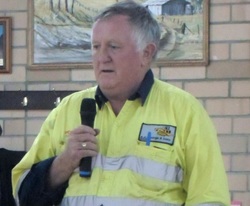
Guest speaker was Eric George, a volunteer firefighter based in Brunswick.
He told of the recent major fire in our area and the devastation it caused from his perspective.
The firefighters attended the fire at 7 am the morning Wednesday 20th January. By 2 pm of that day the edge of the fire had reach Alcoa mine site. By 2.30 pm Alcoa was evacuated and by the next morning the fire was at the coast. Alcoa lost everything except for the refinery.
On the Thursday the fire took out Yarloop.
Friday night the fire went south and by 5:30 am the next day the firefighters thought they had control of it, however by 12 noon the fire jumped in 12 different places. You couldn’t hear the helicopter over the roar of the fire. By Saturday the fire was at Cookernup where the firefighters saved the town 5 times and were still fighting the fire near Cookernup a week later.
Saturday night they were deployed (five crews) to save Vineyard 28. They worked all night as the peat would burn under the ground and then pop up and run again. This fire burnt for 2 weeks.
By this time the fire had a 200 kilometre front.
The devastation was unbearable to the flora and fauna; not to mention the farm animals.
Acres of pine plantation were burnt out and the pine logs had to be harvested urgently as if not a fungus would get into them. In some forests the plantations were 100% burnt out and in one where there were young pines, not only were the young trees destroyed but the topsoil was burnt, in making it a long time before it is arable again.
While harvesting the pines, Eric mentioned that the silence was deafening in as much as there was absolute stillness – no birds or wildlife.
There were 6 harvesters used and some of the logs would be chipped and other logged for timber.
It is estimated it will cost $80 million to replant and as this is government property, it is not known when replanting will take place.
He told of the recent major fire in our area and the devastation it caused from his perspective.
The firefighters attended the fire at 7 am the morning Wednesday 20th January. By 2 pm of that day the edge of the fire had reach Alcoa mine site. By 2.30 pm Alcoa was evacuated and by the next morning the fire was at the coast. Alcoa lost everything except for the refinery.
On the Thursday the fire took out Yarloop.
Friday night the fire went south and by 5:30 am the next day the firefighters thought they had control of it, however by 12 noon the fire jumped in 12 different places. You couldn’t hear the helicopter over the roar of the fire. By Saturday the fire was at Cookernup where the firefighters saved the town 5 times and were still fighting the fire near Cookernup a week later.
Saturday night they were deployed (five crews) to save Vineyard 28. They worked all night as the peat would burn under the ground and then pop up and run again. This fire burnt for 2 weeks.
By this time the fire had a 200 kilometre front.
The devastation was unbearable to the flora and fauna; not to mention the farm animals.
Acres of pine plantation were burnt out and the pine logs had to be harvested urgently as if not a fungus would get into them. In some forests the plantations were 100% burnt out and in one where there were young pines, not only were the young trees destroyed but the topsoil was burnt, in making it a long time before it is arable again.
While harvesting the pines, Eric mentioned that the silence was deafening in as much as there was absolute stillness – no birds or wildlife.
There were 6 harvesters used and some of the logs would be chipped and other logged for timber.
It is estimated it will cost $80 million to replant and as this is government property, it is not known when replanting will take place.
April 2016
Our Guest speaker for April was Mark Chester, CEO of Dardanup Shire; who advised that Dardanup Shire was one of the fastest growing Shires in WA.
Projects the Shire has currently:
WANJU (welcome) Project.
A futuristic model city that will be 30 years in the making. The challenges are many and include the re-alignment of the Bunbury outer ring road east of Martin Pluesey and Hynes Roads; the Waterloo Park Structure Plan with 2 hectares of council depot with the rest sold off as light industrial.
Power to Wanju will be solar and transport will be electric and driver-less buses. No other vehicles in the town site. Water services will be potable, waste and recycling.
Parkridge and Millbridge will be further developed with a new suburb South Bank.
Burekup and Dardanup are destined for future development with Dardanup having 4 more stages of urban development in the future.
There are 5 building projects in the future:
New works depot ($3.5m)
New Football Pavilion ($4.2m)
New softball pavilion ($1m)
New Library/Administration ($10.5m)
Eaton Foreshore ($750,000)
Dardanup Shire is working with the Harvey Shire on a several projects:
Bridge, land and roads ($55m)
New Collie River Bridge ($24m) construction starting late 2016.
Land and administration ($11m) Roads ($24m)
Tourism:
Gnomesville is growing with worldwide attention. New car park plan.
The looking glass Eaton foreshore Economic Development:
In partnership with state government and the greater Bunbury local governments – working on Regional Cities Plan. Eaton Town Centre – Town Square and expansion to Eaton Fair Shopping Centre
Wanju – pushing technology such as driver-less buses, high speed internet, and work from home.
Waterloo Industrial Park. Community events,
The Looking Glass, Bollywood, Casino Royale
March 2016
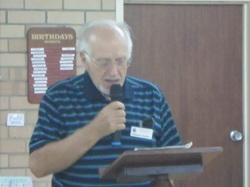
Guest Speaker was Howard Askew who recounted how his fascination for engineering started with a gift of a hot air tractor at 3 years of age and received his first Meccano set at aged 7. As a child he always asked technical questions and loved building in the backyard. By 10 he had a love of maths and at this stage realised he was going to become an Engineer.
He studies engineering at the UK equivalent of TAFE as money was tight in his family.
His first job was in a drawing office of a Civil Engineering Company.
He joined the RAF and trained as a Radar Technician. Howard told some amusing stories of his time in the RAF. He cycled for the RAF team, trained tracker dogs (Alsatians) and was in the Gliding Club.
He told a story of when he was gliding he flew with a buzzard and at another time had to land in a restricted zone (The Portland Down Germ Warfare complex).
After the RAF he worked with a company helping design the 1st graphic computer; then onto making beepers for Doctors. Within his career in this company he had to find solutions for difficult jobs.
In the 1970's he started working on radars for fishing vessels in Cornwell.
Time didn't allow Howard to give a full accounting of his varied and colourful working life and how he cam be be retirustraliand.
He studies engineering at the UK equivalent of TAFE as money was tight in his family.
His first job was in a drawing office of a Civil Engineering Company.
He joined the RAF and trained as a Radar Technician. Howard told some amusing stories of his time in the RAF. He cycled for the RAF team, trained tracker dogs (Alsatians) and was in the Gliding Club.
He told a story of when he was gliding he flew with a buzzard and at another time had to land in a restricted zone (The Portland Down Germ Warfare complex).
After the RAF he worked with a company helping design the 1st graphic computer; then onto making beepers for Doctors. Within his career in this company he had to find solutions for difficult jobs.
In the 1970's he started working on radars for fishing vessels in Cornwell.
Time didn't allow Howard to give a full accounting of his varied and colourful working life and how he cam be be retirustraliand.
February 2016
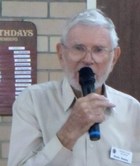
Guest speaker was Kevin Keeley who started his talk with a quotation from the famous poem by Dorethea McKeller – A Sunburnt Country.
Starting 1953 for 12 years Kevin called into Yarloop on business. When he first arrived in Yarloop there was an overhead bridge over the railway line connecting the residential and the commercial sectors of Yarloop. In the 1950’s the hardware store and the pub burnt down. Yarloop was a great town with strong community spirit and their fair share of characters. One such was “Honest Mac” and Kevin told us an amusing story involving an antenna and an amplifier about Mac. Another such character was Dr Knight the local GP for over 30 years. He played the organ in the local church and his car was the local ambulance. He also ran a good hospital for the local timber workers.
The workshop had the largest lathe in the southern hemisphere and turned out the barrels for the large guns on the British warships. They could also make an engine from scratch and the truck to go with it.
When the recent fires went through there so much history was destroyed.
Peter Hill who went to school in Yarloop recanted how his grandfather used to make the big wheels for the timber drays in the workshop and had memories of going there after school.
Kevin left us with the thought “Honesty without Fear or Favour”.
As a footnote; Yarloop was this year (2016) to be put on the World Heritage list – now of course this will not happen.
Starting 1953 for 12 years Kevin called into Yarloop on business. When he first arrived in Yarloop there was an overhead bridge over the railway line connecting the residential and the commercial sectors of Yarloop. In the 1950’s the hardware store and the pub burnt down. Yarloop was a great town with strong community spirit and their fair share of characters. One such was “Honest Mac” and Kevin told us an amusing story involving an antenna and an amplifier about Mac. Another such character was Dr Knight the local GP for over 30 years. He played the organ in the local church and his car was the local ambulance. He also ran a good hospital for the local timber workers.
The workshop had the largest lathe in the southern hemisphere and turned out the barrels for the large guns on the British warships. They could also make an engine from scratch and the truck to go with it.
When the recent fires went through there so much history was destroyed.
Peter Hill who went to school in Yarloop recanted how his grandfather used to make the big wheels for the timber drays in the workshop and had memories of going there after school.
Kevin left us with the thought “Honesty without Fear or Favour”.
As a footnote; Yarloop was this year (2016) to be put on the World Heritage list – now of course this will not happen.
January 2016
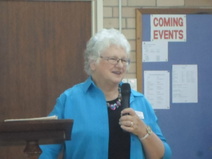
Guest speaker was Kerry Shardlow who spoke mainly on her experiences in palliative care.
Kerry was an only child and as such was the centre of her mother’s life. Her father left when she was 3 and over the years she learnt a lot about grief.
Kerry did pharmacy at ECU, married at 23 and then with her husband went over to the UK and worked in pharmacy for a couple of years.
WWhen they returned to Australia, they adopted 2 children and life went on with children and being a working mother.
Kerry was given the opportunity to do a course in Chaplaincy at RPH and her first placement was at St John of God Hospital working with cancer patients.
In 1982 she and her family moved to Bunbury and it was at this time her mother was diagnosed with cancer.
In 1984 she was approached by Silver Chain to work on a voluntary basis 2-3 days per week visiting cancer patients, which led to a full time position. Palliative care was new to Bunbury and a public meeting was held to gauge public feeling. The response was that over 80 people turned up – so the service was started.
From this they trained volunteers and of the 25 that came forward, only 10 stayed. 1987 was the first year of operation with 4 patients. It took 2-3 years before the public and doctors gained confidence in the service.
In 1991 Kerry did a 3 month live-in course in palliative care, which she has never regretted as it was on the holistic approach to palliative care.
Her team had strong goals of high palliative care and so many went far and beyond the call of duty.
Kerry then went onto tell some poignant and sometimes amusing stories from her career as a palliative carer.
It was interesting to note that not all patients were elderly. Patients were from babies to over 100.
December 2015
In December we did not have a guest speaker.....however we had an activity whereby members had to put names to members’ baby photos. This proved surprisingly difficult however several members did get a few correct.We also had a mystery object or treasured item segment.
James Wright bought along a mystery item and asked if anyone knew what is was. Don Wass came up with the best explanation.
Howard Askew’s valued item was given to him when he was at school and when his computer plays up he reminds it, it is not irreplaceable. (A slide rule).
Lesley Malcolm bought along a brass sheep drench. A family member (Roy Hopkins) bought a farm in Harvey and that the item was a reminder of her Uncle Roy.
Kerry Shardlow’s treasured item was from an elderly lady in the UK. A beautiful handmade drawn thread work table cloth.
Les Bail advised his treasured item is his wife. (Brownie points there)
Glenice Stamp’s item was inherited from her mother who found it on the side of a railroad. It is a Staffordshire statue of a Christening group, which if not damaged would be quite valuable.
James Wright bought along a mystery item and asked if anyone knew what is was. Don Wass came up with the best explanation.
Howard Askew’s valued item was given to him when he was at school and when his computer plays up he reminds it, it is not irreplaceable. (A slide rule).
Lesley Malcolm bought along a brass sheep drench. A family member (Roy Hopkins) bought a farm in Harvey and that the item was a reminder of her Uncle Roy.
Kerry Shardlow’s treasured item was from an elderly lady in the UK. A beautiful handmade drawn thread work table cloth.
Les Bail advised his treasured item is his wife. (Brownie points there)
Glenice Stamp’s item was inherited from her mother who found it on the side of a railroad. It is a Staffordshire statue of a Christening group, which if not damaged would be quite valuable.
November 2015 - Commodore Bob Trotter (Retired)
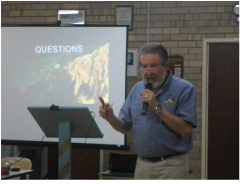
Our guest speaker was Commodore Bob Trotter (Retired) who has a very impressive resume having served on the HMAS Vampire and Melbourne, sailed in submarines and the Aid de Corp to the Governor General and the manager of all Naval Bases in WA prior to retirement.
However it was after retirement that he was able to achieve something that had been lost for 60 years – the finding of HMAS Sydney that went down with all hands during the Second World War.
1939 The Sydney was commissioned and was based in Fremantle.
1940 (mid) The Sydney joined the Mediterranean Fleet and saw combat with great success.
October 1941 Returned to Australia and was given a hero’s welcome to all hands by the city of Sydney. After a brief refit, Sydney did trade protection duties in and around Australian waters.
27 October 1941 The Sydney visited Bunbury and this was the last anyone saw of the ship as 3 weeks later it was lost at sea
11 November 1941 The Sydney left Fremantle on escort duties to HMAS Zealander who was carrying the ill-fated 8th Division.
.1941 – 1943 German raiders in ships that resembled merchant tramp ships, would incapacitate an allied ship; offload supplies and then sink the ship with all hands. In this manner they were able to stay at sea indefinitely.
19 November 1941 The Kormoran, a German Raider, (ship 41) with a crew of 400 met with Sydney and engaged. The cruise ship Centaur was heading back to Fremantle from Singapore and took film of a search aircraft and found a lifeboat containing Germans from the Kormoran and took aboard the injured. In all around 300 survivors from the Kormoran were found.
645 Men on the Sydney were not found as the planes were flying too high and their intel was to look for a ship – not survivors of a wreck.
1975 - 2001 Interest rekindled in the search for HMAS Sydney.
The Government at the time’s position was there was no direct evidence that could provide a search for the Sydney. However a small group of men thought differently and in 2002 the “Finding Sydney Foundation” was formed.
2002 – 2004 The German survivors of Kormoran were interviewed. With this knowledge and the expert advice of several professors – the general area to be searched was put forward. Finally in 2008 $5,230,000 was raised enabling the search of the Sydney to go ahead.
12 March 2008 Kormoran was found in 2.5m of water off Shark Bay. 60 Hours later Sydney was found at 10am on the 16 March 2008 at 246m down.
Feb 2009 Lone survivor of the Sydney was found on Christmas Island
However it was after retirement that he was able to achieve something that had been lost for 60 years – the finding of HMAS Sydney that went down with all hands during the Second World War.
1939 The Sydney was commissioned and was based in Fremantle.
1940 (mid) The Sydney joined the Mediterranean Fleet and saw combat with great success.
October 1941 Returned to Australia and was given a hero’s welcome to all hands by the city of Sydney. After a brief refit, Sydney did trade protection duties in and around Australian waters.
27 October 1941 The Sydney visited Bunbury and this was the last anyone saw of the ship as 3 weeks later it was lost at sea
11 November 1941 The Sydney left Fremantle on escort duties to HMAS Zealander who was carrying the ill-fated 8th Division.
.1941 – 1943 German raiders in ships that resembled merchant tramp ships, would incapacitate an allied ship; offload supplies and then sink the ship with all hands. In this manner they were able to stay at sea indefinitely.
19 November 1941 The Kormoran, a German Raider, (ship 41) with a crew of 400 met with Sydney and engaged. The cruise ship Centaur was heading back to Fremantle from Singapore and took film of a search aircraft and found a lifeboat containing Germans from the Kormoran and took aboard the injured. In all around 300 survivors from the Kormoran were found.
645 Men on the Sydney were not found as the planes were flying too high and their intel was to look for a ship – not survivors of a wreck.
1975 - 2001 Interest rekindled in the search for HMAS Sydney.
The Government at the time’s position was there was no direct evidence that could provide a search for the Sydney. However a small group of men thought differently and in 2002 the “Finding Sydney Foundation” was formed.
2002 – 2004 The German survivors of Kormoran were interviewed. With this knowledge and the expert advice of several professors – the general area to be searched was put forward. Finally in 2008 $5,230,000 was raised enabling the search of the Sydney to go ahead.
12 March 2008 Kormoran was found in 2.5m of water off Shark Bay. 60 Hours later Sydney was found at 10am on the 16 March 2008 at 246m down.
Feb 2009 Lone survivor of the Sydney was found on Christmas Island
October 2015 - Judy Gilder
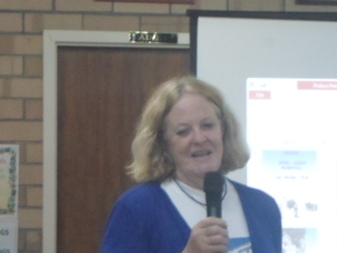
Judy Gilder is a midwife who does volunteer work at the Edna Adan Hospital in Somaliland (local name for Somalia). Somaliland is strategically important as situated at the entrance to the Gulf of Aden.
In 2014, Edna Adan bought a young lady to Australia for facial surgery which was supported by Rotary. The girl was very deformed and the surgery was successful.
Judy recently had a fund raiser for Doctors without Borders at her house in Australind and Edna Adan was in attendance. The fund raiser was for Natal and Intensive care unit at the hospital, this was successful and Judy was able to take over a variety of donated instruments and dressings which were gratefully received.
She talked briefly about people trafficking, where wealthy families are targeted as they are offered transportation to Italy and a better life. At the borders (in Africa) they are held for ransom and if can’t pay are shot. In one instance 60 started and only 6 arrived in Italy.
The hospital depends on aid workers from all over the world. It is also a training hospital for local midwives (an American charity supports the training program).
In 2014, Edna Adan bought a young lady to Australia for facial surgery which was supported by Rotary. The girl was very deformed and the surgery was successful.
Judy recently had a fund raiser for Doctors without Borders at her house in Australind and Edna Adan was in attendance. The fund raiser was for Natal and Intensive care unit at the hospital, this was successful and Judy was able to take over a variety of donated instruments and dressings which were gratefully received.
She talked briefly about people trafficking, where wealthy families are targeted as they are offered transportation to Italy and a better life. At the borders (in Africa) they are held for ransom and if can’t pay are shot. In one instance 60 started and only 6 arrived in Italy.
The hospital depends on aid workers from all over the world. It is also a training hospital for local midwives (an American charity supports the training program).
September 2015 - Ray Grant
Ray Grant who is the principal of Pension and Planning Services and also ex Centrelink employee, gave us a very informative talk on what the changes to the pension entitlements mean.
Ray was with Centrelink for 30 years and managed several offices throughout WA. Before leaving Centrelink he was the Financial Information Officer in Bunbury. In 2001 he obtained his CFP (Certified Financial Planner) and now has his own practice – Pension Planning Services.
In 1901 Pensions started at aged 65. This was in a time when the life expectancy was 58. It is now 85 for men and higher for women.
Allocated pension is the better way to go, however it may restrict cash withdrawals and you must take a minimum amount each month (4% of balance). If this is more than you need you cannot redeposit into pension account. At present you are allowed to have 1.5 million asset level. However this is dropping to $820,000.
You are allowed to gift $10,000 per annum or $25,000 in 5 years.
It is essential that you have a will, an enduring power of attorney and Guardianship in place.
If you need to contact Centrelink – going online is the best and quickest way.
Ray was with Centrelink for 30 years and managed several offices throughout WA. Before leaving Centrelink he was the Financial Information Officer in Bunbury. In 2001 he obtained his CFP (Certified Financial Planner) and now has his own practice – Pension Planning Services.
In 1901 Pensions started at aged 65. This was in a time when the life expectancy was 58. It is now 85 for men and higher for women.
Allocated pension is the better way to go, however it may restrict cash withdrawals and you must take a minimum amount each month (4% of balance). If this is more than you need you cannot redeposit into pension account. At present you are allowed to have 1.5 million asset level. However this is dropping to $820,000.
You are allowed to gift $10,000 per annum or $25,000 in 5 years.
It is essential that you have a will, an enduring power of attorney and Guardianship in place.
If you need to contact Centrelink – going online is the best and quickest way.
August 2015 - Gary Birch
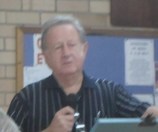
Gary Birch, a retired police officer and an expert in forensic policing was our guest speaker today.
Gary joined the police force in 1971 and his first posting was to Albany. During his term in Albany he was stabbed, held at gunpoint and had his introduction to sudden death.
In January 1976 he was transferred to the Forensic Branch, where his main duties were to attend any suspicious deaths, mainly ballistics and fingerprints. While there he did many courses and became an accredited expert on fingerprints (one of only a few in Australia)
Fingerprints are the ridged section of your fingers that give us grip. No two are the same as because of this fingerprint matching is admissible in a court of law. To get a match you only need a quarter of the top of a finger. In a court of law you need to have 12 points matching.
Gary also became an expert with his own team on crime scenes and arson.
He told us of a case that had a successful outcome but involved his team going through a rubbish dump and how persistence can pay off.
He gave us examples of several cases he and his team attended and the diversity of the cases. He also was involved in the Bernie case.
In January 1989, he became the first forensic policeman in regional WA
Gary retired in 1991 from the police force and started a business called Nightguard Security. He fully retired this year in 2015.
Gary joined the police force in 1971 and his first posting was to Albany. During his term in Albany he was stabbed, held at gunpoint and had his introduction to sudden death.
In January 1976 he was transferred to the Forensic Branch, where his main duties were to attend any suspicious deaths, mainly ballistics and fingerprints. While there he did many courses and became an accredited expert on fingerprints (one of only a few in Australia)
Fingerprints are the ridged section of your fingers that give us grip. No two are the same as because of this fingerprint matching is admissible in a court of law. To get a match you only need a quarter of the top of a finger. In a court of law you need to have 12 points matching.
Gary also became an expert with his own team on crime scenes and arson.
He told us of a case that had a successful outcome but involved his team going through a rubbish dump and how persistence can pay off.
He gave us examples of several cases he and his team attended and the diversity of the cases. He also was involved in the Bernie case.
In January 1989, he became the first forensic policeman in regional WA
Gary retired in 1991 from the police force and started a business called Nightguard Security. He fully retired this year in 2015.
July 2015 - Mark Townsend - S.A.F.E
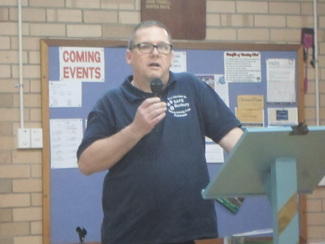
Mike Townsend from SAFE (Save animals from Euthanasia), together with his assistant Lisa, gave us a short talk on the history and activities of the organisation.
It was founded in 2003 in the Pilbara and their mission is to ensure that any companion animal is re-homed.
Animals manly come from the pound and there is a network of foster carers who care for the animal until re-homed. AWALA (Animal Welfare League of Australia) who are affiliated with SAFE, supply food for the animals. They also work very closely with the RSPCA.
In the 2014/2015 year, SAFE found homes for 298 cats, 210 dogs, and 8 rabbits. SAFE pays for Vet bills such as de-sexing, inoculations and micro chipping.
Funds come from the sale of animals that are re-homed and fund raising within the community and they are always on the lookout for foster carers, mainly for older animals.
If a person wanted a dog or cat, SAFE will match animal to new owners needs and will follow up on de-sexing. However most owners contact SAFE to tell them how the animal has settled in.
There is a 2 week trial period for all re-homed pets and average cost is around $430.
Micro chipping is mandatory.
It was founded in 2003 in the Pilbara and their mission is to ensure that any companion animal is re-homed.
Animals manly come from the pound and there is a network of foster carers who care for the animal until re-homed. AWALA (Animal Welfare League of Australia) who are affiliated with SAFE, supply food for the animals. They also work very closely with the RSPCA.
In the 2014/2015 year, SAFE found homes for 298 cats, 210 dogs, and 8 rabbits. SAFE pays for Vet bills such as de-sexing, inoculations and micro chipping.
Funds come from the sale of animals that are re-homed and fund raising within the community and they are always on the lookout for foster carers, mainly for older animals.
If a person wanted a dog or cat, SAFE will match animal to new owners needs and will follow up on de-sexing. However most owners contact SAFE to tell them how the animal has settled in.
There is a 2 week trial period for all re-homed pets and average cost is around $430.
Micro chipping is mandatory.
June 2015 - Cassandra Fisher
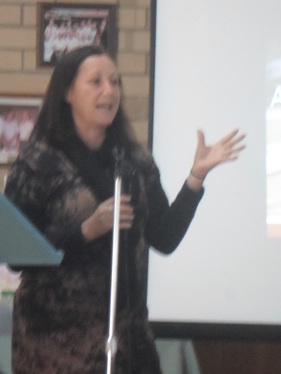
Cassandra Fisher (Cassie) gave us an eye opening talk on Aromatherapy and essential oils.
Essential oil is extracted from the cells of the plant and is then distilled by steam. Although not flowers; such as rose or jasmine.
The grade of the oil is important and she warned us to be careful when buying essential oils. For example – it takes many tons of rose petals to make a small bottle of rose oil and wholesales for over $200. Therefore when you buy rose oil at $20, you can be assured it isn’t.
Indigenous plants to a country are 16% more potent. For example lavender from France is more potent than lavender from Australia.
We saw a short film clip on the extraction of oil that has only been extracted commercially for a short time from the Cedar Tree. (Thuja Plicata). It is called Arbourvita – The Tree of Life.
All oils have a note and the blending of the oils is an art.
Top notes – citrus (lemon/orange)
Middle notes –floral
Bottom note – Peppermint
Base note – woody (This is grounding and binding)
All oils are pharmacy quality and should always be stored in glass.
The 3 basics for everyday use are:
· Lavender – good all-rounder (middle note)
· Lemon – Antiseptic
· Peppermint - uplifting
During the talk examples of the various oils were passed around the smell the aroma and she had an infusion of an orange blend wafting over the audience to keep us all alert.
Essential oil is extracted from the cells of the plant and is then distilled by steam. Although not flowers; such as rose or jasmine.
The grade of the oil is important and she warned us to be careful when buying essential oils. For example – it takes many tons of rose petals to make a small bottle of rose oil and wholesales for over $200. Therefore when you buy rose oil at $20, you can be assured it isn’t.
Indigenous plants to a country are 16% more potent. For example lavender from France is more potent than lavender from Australia.
We saw a short film clip on the extraction of oil that has only been extracted commercially for a short time from the Cedar Tree. (Thuja Plicata). It is called Arbourvita – The Tree of Life.
All oils have a note and the blending of the oils is an art.
Top notes – citrus (lemon/orange)
Middle notes –floral
Bottom note – Peppermint
Base note – woody (This is grounding and binding)
All oils are pharmacy quality and should always be stored in glass.
The 3 basics for everyday use are:
· Lavender – good all-rounder (middle note)
· Lemon – Antiseptic
· Peppermint - uplifting
During the talk examples of the various oils were passed around the smell the aroma and she had an infusion of an orange blend wafting over the audience to keep us all alert.
May 2015 - Roy Scott
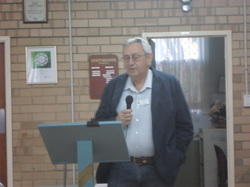
Roy Scott, a retired Police Officer, gave us a short talk on his life in the Police Force. He joined in 1966 and after his 6 months of training had trial by fire as his first foot patrol was the anti-conscription rally against the Vietnam War. It was a bit hairy!
He served as a Constable in several country stations, then was transferred back to Central and promoted to Liaison Officer to the Minister – Graeme Edwards.
From there he became acting Police Prosecutor in Bunbury and finally to the Central Law Courts as Prosecutor where he could have up to 200 cases per day. Thankfully not all went onto trial. By this time he had risen in the ranks to Inspector and his position took all over WA. He also had the unenviable job of also having to prosecute errant police officers.
He gave us several examples of cases that he dealt with and my impression was “a policeman’s lot is not a happy one” and the backbone of any policeman is his wife
He served as a Constable in several country stations, then was transferred back to Central and promoted to Liaison Officer to the Minister – Graeme Edwards.
From there he became acting Police Prosecutor in Bunbury and finally to the Central Law Courts as Prosecutor where he could have up to 200 cases per day. Thankfully not all went onto trial. By this time he had risen in the ranks to Inspector and his position took all over WA. He also had the unenviable job of also having to prosecute errant police officers.
He gave us several examples of cases that he dealt with and my impression was “a policeman’s lot is not a happy one” and the backbone of any policeman is his wife
April 2015 - Amy Pitt
Amy is the Community Program Manager for Milligan Community Center and she gave an informative talk on the role of Milligan Community Center in the community.
Milligan was established in 1986 and now in 2015, it is kept running by local government funding. Community education is the main agenda with Milligan for kids and the homework center one of the more popular programs.
Due to a lack of funding they had to take a new direction and start short courses open to the general public. The courses are in various centers with Eaton having Drawing and Italian cooking.
Milligan was established in 1986 and now in 2015, it is kept running by local government funding. Community education is the main agenda with Milligan for kids and the homework center one of the more popular programs.
Due to a lack of funding they had to take a new direction and start short courses open to the general public. The courses are in various centers with Eaton having Drawing and Italian cooking.
March 2015 - Sam Morris
Sam Morris who is the proprietor of Taffy’s, gave us a delightfully humorous talk on his life and how he ended up making his family’s recipe for candy on a commercial basis.
In primary school is teacher gave him a love for history and he followed this up with a Degree in History. However while he was studying, in his summer breaks he hitch hiked around the USA doing odd jobs which gave us some very funny stories.
In 1971 when he was near to graduating someone gave him an ad for a teaching position in NSW which he carried around with him until 1972 actually applied for the position. He was 22 years of age.
His first year was in Mullumbimby then Cabramatta for 1 year. On finishing his 2 years he travelled around Asia and New Zealand. He soon came back and was became the House Master at Harvey Ag School. With his mother in poor health he went home and did further studies and then returned to WA (I think he is an Aussie at heart) and taught at Bunbury, Newton Moore and Australind High Schools.
In 1995 he had the idea for Taffy’s but it didn’t become a reality until 2002. The Peanut Brittle sold there is his Aunt Dorothy’s recipe which was sold all over the world for45 years. He told us the origins of Salt Water Taffy
In primary school is teacher gave him a love for history and he followed this up with a Degree in History. However while he was studying, in his summer breaks he hitch hiked around the USA doing odd jobs which gave us some very funny stories.
In 1971 when he was near to graduating someone gave him an ad for a teaching position in NSW which he carried around with him until 1972 actually applied for the position. He was 22 years of age.
His first year was in Mullumbimby then Cabramatta for 1 year. On finishing his 2 years he travelled around Asia and New Zealand. He soon came back and was became the House Master at Harvey Ag School. With his mother in poor health he went home and did further studies and then returned to WA (I think he is an Aussie at heart) and taught at Bunbury, Newton Moore and Australind High Schools.
In 1995 he had the idea for Taffy’s but it didn’t become a reality until 2002. The Peanut Brittle sold there is his Aunt Dorothy’s recipe which was sold all over the world for45 years. He told us the origins of Salt Water Taffy
February 2015 - Bob Menzies
Bob Menzies gave us an entertaining talk on the life of a British Administrator in Zimbabwe (then Rhodesia). His duties were varied in the Native Department of the District Administrator and included adjudicating the bride price of cattle (that was a very interesting story) to tribal customs such as marriage, tribal chieftain succession, tribal boundaries and sometimes even tribal wars. He also had to meet daily with terrorists, who attacked the local villages. He could speak the local language fluently; which was no mean feat as there are over 300 words just to cover the colour of a cow hide.
During the transition to independence of Zimbabwe, he oversaw the election of the first President, but grew disenchanted with the incumbent government. So still in Zimbabwe, for a while he became Chief Executive of the Chamber of Commerce, then office manager in a law firm. He left the firm as his salary was not enough to make ends meet.
He immigrated to Australia to enjoy his retirement and be near his family in Dalyellup.
During the transition to independence of Zimbabwe, he oversaw the election of the first President, but grew disenchanted with the incumbent government. So still in Zimbabwe, for a while he became Chief Executive of the Chamber of Commerce, then office manager in a law firm. He left the firm as his salary was not enough to make ends meet.
He immigrated to Australia to enjoy his retirement and be near his family in Dalyellup.
January 2015 - Roy Scott
Roy Scott gave an extremely interesting talk on the history of the Hotham Valley Tourist Railway, their ups and downs. How red tape has killed off a popular tourist pastime. He also talked about the various engines and carriages that he has either worked on or driven (if that is the correct term). In all he impressed with his passion for his – dare we say –hobby.


